 |  | | THE ARKWOOD EXPERIMENT |
| |  |  | | SCRIPT: Roger Noel Cook
ART: John Canning ISSUES: 944 - 949
COVER DATES: 17 January 1970 - 21 February 1970
ON TV: Spearhead from Space - The Silurians (Season 7)
REPRINTS: Doctor Who Classic Comics, Issue 4, March 1993. The Brigadier summons Doctor Who to the local zoo where they are soon attacked by animals that are usually placid. Doctor Who realises the attacks started after a visit from a party of school children from the Arkwood Private School. He and the Brigadier go there at once, but are too late to stop pupil Cedric Matthews unleashing his ‘change’ drug on his fellow students in an attempt to take over the country. The Doctor produces a pacifying drug in the school’s chemistry lab which stops the rampaging pupils in Arkwood village. Matthews, meanwhile, is sent to a detention centre. |
 |  | | ALTERED VISTAS SAYS:
Not the most illustrious start to the Third Doctor’s comic strip reign, as we see him menaced by savage parrots, crazed penguins, and then some ferocious ten-year-olds. As a heavy caricature, Canning’s likeness of Pertwee is as passable as his Second Doctor, though his Brigadier could be anyone in an army uniform. This strip does boast one of the most bizarre Next Week captions ever committed to print: ‘Can Dr. Who and the Brigadier escape the frenzied parrots? See next week!’ Bonkers, I say. It is interesting that the first mention of Arkwood School in the strip’s second part has been changed from something else and is written in a different hand... |
| |
|
|
 |  | | THE MULTI-MOBILE |
|  |  | | SCRIPT: Roger Noel Cook
ART: John Canning ISSUES: 950 - 954
COVER DATES: 28 February 1970 - 28 March 1970
ON TV: The Silurians - The Ambassadors of Death (Season 7)
REPRINTS: None When three foreign agents hijack an advanced armoured vehicle and plan to use it to destroy the British Nuclear Defence Control Centre. After an ambush at a petrol station by UNIT fails, the Doctor steps in and drops sugar cubes in the vehicle’s petrol tank which causes its engines to seize up whilst crossing the marshes close to the centre. The Multi-Mobile sinks into the marsh. |
| |
 |  |  |  |  | | | 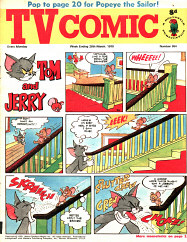 | | ALTERED VISTAS SAYS:
Although it is commendable that writer Roger Noel Cook, much like his TV counterparts on Season 7, tries to avoid the good old fashioned invasion of Earth storyline, this one is frankly a bit of a duffer in Doctor Who terms and would have worked better for another TV Comic strip such as The Avengers, though there is some nice interplay between the Doctor and the Brigadier in the first part, with the former keen to repair the TARDIS and the latter keen for the Doctor to become involved in UNIT affairs if he wants to keep getting the resources he needs. I wonder how many children actually tried dropping sugar cubes in their dads’ petrol tanks, just to see if the Doctor’s solution worked... | | | | IMAGINARY FRIENDS - THE BRIGADIER The Brigadier is such an integral part of the Third Doctor’s era on television, that it is something of a surprise just how little he features in the comic strip version. He is there at the start, though, and usually acts as a generic companion for the Doctor, asking questions and getting told important plot points - a far cry from the Brigadier of TV’s Season 7, though perhaps not so far removed from the character of Season 10 onwards - though he does have moments of authority, especially once the character of Liz Shaw has been introduced, even if he mainly acts to introduce the Doctor to the story. However, once Alan Fennell took over the writing duties, both UNIT and the Brigadier were quietly forgotten about, at least until the 1971 TV Comic annual where we learn that the Brigadier has a yacht in the Caribbean where he takes cruises in the summer! Neither he nor UNIT survived the transfer to Countdown, though, and, annuals and specials aside, it has been largely left to the latter day strips such as Change of Mind to represent him as part of the Third Doctor’s comic strip era. | | | | | |  | | |
|
 |  | | INSECT |
 |  |  |  |  |  |  |  |  |  |  |  |  |  |  |  |  | | SCRIPT: Roger Noel Cook
ART: John Canning ISSUES: 955 - 959
COVER DATES: 4 April 1970 - 2 May 1970
ON TV: The Ambassadors of Death (Season 7)
REPRINTS: None A new insecticide creates huge insects that rampage across the British countryside, including caterpillars, ants and daddy longlegs. The Doctor realises the insecticide has been wrongly mixed and finds an antidote that returns the insects to their normal dimensions. | |  | | |  | |  | |  | | | | | | | | | | ALTERED VISTAS SAYS:
There seems to be a running theme developing of the Third Doctor being menaced by unlikely Earth creatures - so far, only three stories into his run, we’ve had parrots, penguins, school kids, caterpillars and daddy longlegs! This story is simple, and easily resolved with the Doctor once again mixing a convenient antidote, but it probably captured the imagination of the comic’s intended readership, who always like oversized insects. | | | 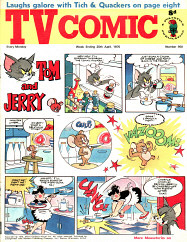 | |  | | | | | | | | 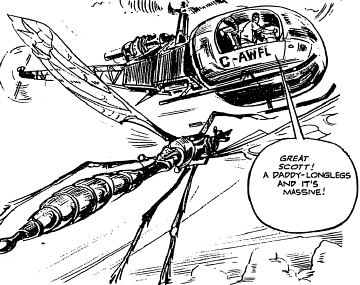 | | | | | 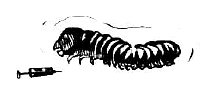 | | | | |
 |  | | THE METAL EATERS |
 | | |  |
|  |  | | SCRIPT: Unknown
ART: John Canning ISSUES: 960 - 964
COVER DATES: 9 May 1970 - 6 June 1970
ON TV: Inferno (Season 7)
REPRINTS: None A meteor crashes to Earth. Deemed harmless, it is transported to a museum, but it stops twice en route and at each location - a bridge and a transport cafe close to a chemical works - some strange iron filings are released which corrode metal. Doctor Who realises that three lots of filings were actually released from the meteor, the third lot at the crash site, and they use an anti-corrosive liquid to end the threat. |
|  |  | | ALTERED VISTAS SAYS:
A vast improvement on the previous Third Doctor strips, despite the solution to the problem being sign posted early on - at least this avoids another session of the Doctor concocting yet another antidote in some laboratory just in time to save the day. There are signs of intelligence lurking behind this strip which does help to lift it, and the alien menace is fairly well thought out. This strip shouldn’t be confused with the other Third Doctor strip of the same name (see here), which is a lot of fun but perhaps not so intelligent. |
|
|
|  |  | | IMAGINARY FRIENDS - LIZ SHAW Making her TV Comic debut just as her TV counterpart was about to sign off, Liz Shaw is actually handled fairly well by the comic strip in the brief time that she is allotted; she gets to make scientific observations and even looks a little like Caroline Johns if you squint a lot. Liz measures the effectiveness of the new depth charge being tested by UNIT in The Fishermen of Carpantha. In the same story it is revealed that she carries a lighter, so presumably she nips outside for a crafty fag when the Doctor’s not looking. After analysing the Rocks from Venus, Liz quietly disappeared from the TV Comic strip after only three stories. Mind you, UNIT and the Brigadier were also forgotten about soon after. She did return for Change of Mind in 1995, which was set after she had already left UNIT and, with typical fannish concern, details why she left the organisation. The only alien race Liz encountered in the comic strips was the fishermen of Carpantha.
|
|
 | | |  |
 |  | | ASSASSIN FROM SPACE |
|  |  | | SCRIPT: Roger Noel Cook
ART: Patrick Williams COVER DATES: May 1970
ON TV: Inferno (Season 7)
REPRINTS: None Aliens decide to kill Doctor Who before they begin their invasion of Earth, but their attempt to carry out their plan in a foggy London park comes to nothing thanks to the Doctor’s trusty cane, which contains a sword and a laser. | | | ALTERED VISTAS SAYS:
Williams’ likeness of Pertwee isn’t the most flattering and does tend to make him look like a dirty old man, although there is a certain simplistic vigour in the artwork in general. Sadly, the script is a bit rubbish, and the Doctor’s gadget of the week harks back to various strips of the Second Doctor. |
| |
 |  | | UNDERCOVER |
|  |  |  | | SCRIPT: Roger Noel Cook
ART: Patrick Williams COVER DATES: May 1970
ON TV: Inferno (Season 7)
REPRINTS: None When a ‘small device’ is stolen from UNIT by foreign agents, the Doctor dresses as an old woman and uses his obedience spray to get it back. | | | ALTERED VISTAS SAYS:
I could do with some obedience spray when I go out at the weekend, though hopefully you don’t have to dress as a woman for it to work.... The strip? Well, it’s simple-minded space-filler really. |
| |
 |  | | THE FISHMEN OF CARPANTHA |
 |  | | ROCKS FROM VENUS |
|  |  | |  | | SCRIPT: Alan Fennell
ART: John Canning ISSUES: 970 - 976
COVER DATES: 18 July 1970 - 29 August 1970
REPRINTS: None The Doctor is called in by the Brigadier to a top secret rocket base hidden in the Highlands of Scotland. Here he meets Professor Logan who claims to have sent three men to Venus. The Brigadier asks the Doctor to examine rock samples from the expedition, but the Doctor quickly realises that the samples are fake and probably come from Nevada. Returning to the complex to learn why Logan is lying, the Doctor is given a pass to visit Logan at his sprawling ancestral home, the upkeep of which must be exorbitant. Fearing that the Doctor will reveal his fraud, Logan and the astronauts in his pay bundle the Doctor aboard a rocket and launch him into space to keep him quiet. However, the Doctor takes control of the rocket and threatens to crash it into Logan’s ancestral home - the real reason why Logan wants funds from the government. Logan confesses his fraud and the Doctor lands safely. | | | 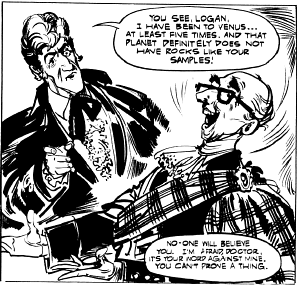 | |
|  | | |  | | | ALTERED VISTAS SAYS:
An odd story that feels more like an episode of The Avengers than Doctor Who, though the rocket base does vaguely evoke the setting of The Ambassadors of Death. At seven episodes it is also somewhat overlong - this strip, not The Ambassadors of Death. On the plus side, the Doctor is characterised well, especially in the opening instalment. Canning’s art veers between the rather good, particularly when it comes to the rocket scenes and the depictions of the Scottish Highlands, and the downright bizarre, with the Doctor and Logan seemingly in a contest to out-caricature each other, growing steadily more strange-looking as the strip progresses. The Doctor’s car (unnamed in this strip) finally puts in an appearance, though how the Doctor cannibalises some of her engine parts to make a suspended animation machine is frankly anybody’s guess. |
|
|
 |  | | DOCTOR WHO AND THE ROBOT |
 |  | |  |  | | SCRIPT: Alan Fennell
ART: John Canning ISSUES: 977 - 984
COVER DATES: 5 September 1970 - 24 October 1970
REPRINTS: None Professor Carl Readon has developed an advanced robot with emotions, but asks his friend Doctor Who to check over its circuits to make sure it is free from malfunctions. The Doctor does this but finds no errors. However, the next day, shortly after Professor Readon has told off his lab assistant Jane Francis for always bringing her dog to work, the robot goes berserk and smashes its way out of the laboratory. The police are unable to stop it, as is a marksman under Doctor Who’s guidance, and eventually the military call in a tank to finish the robot for good. However, Doctor Who realises that the robot misses the dog and hurries to reunite the two, solving the problem. | | | |  | | | | ALTERED VISTAS SAYS:
A robot that develops an emotional attachment and goes on a rampage, coming up against a tank... why, it’s Robot five years too soon! Perhaps a little overlong, which makes the resolution feel weak, but a fairly exciting story that builds well until the last instalment. |
| |
 |  | | TRIAL OF FIRE |
|  |  |  |  |  |  |  | | SCRIPT: Alan Fennell
ART: John Canning ISSUES: 985 - 991
COVER DATES: 31 October 1970 - 12 December 1970
REPRINTS: None When an inn owned by ex-detective Tom Streeter is burned to the ground, and samples of lava are found in the ruins, Doctor Who is called in to investigate. He soon meets Professor Vinter, an expert in volcanology, who arouses his suspicions - and rightly too, for Vinter is communicating with a race of Fire People who live in the centre of the Earth. With Tom, he manages to get a sample of lava for analysis, despite the Fire People trying to destroy him with a wave of living lava. The lava matches samples found in the great lava lake in Africa, so Doctor Who and Tom travel there by plane. Venturing underground, they soon meet the Fire People, but this is a peaceful group led by Pheonard, who reveals that a faction of his people have fallen in league with Vinter. Tom, it turns out, was once on the trail of an arsonist named Vinter. Vinter’s faction attacks but Doctor Who and Tom escape back to the recently refuelled plane and manage to take off. They head to the Antarctic. Using passages within the Earth, together with a tracking system, Vinter and his faction follow them, but they are unable to withstand the cold - the Fire Creatures burn out and Vinter collapses. Pheonard’s people lead the Doctor and Tom back to safety. | | | | ALTERED VISTAS SAYS:
Taking in Wiltshire, Africa and the Antarctic, and with a strong and logical plot, Trial of Fire is a good story, with much exciting incident, that justifies its length. It is clear that John Canning is much happier drawing planes and real-world things rather than aliens, and the Fire People never look anything more than just plain silly, but this doesn’t undermine a story that is told with great comic strip panache. With the Silurians, their (not yet revealed) undersea cousins the Sea Devils, the Carpanthans and now the Fire People, it’s getting very crowded beneath the surface of the Earth... | | | | 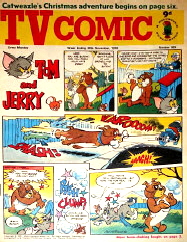 | | 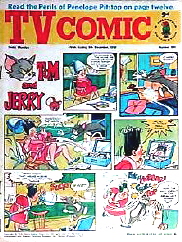 |
| |
 | | |  |
 |  | | CASTAWAY |
 | | |  |
|  |  |  | | SCRIPT: Roger Noel Cook
ART: John Canning Whilst taking a cruise on the Brigadier’s yacht in the Caribbean, the Doctor is attacked by a giant octopus. Attempting to assist him, the Brigadier’s rifle is snatched by a leaping dolphin. The two men are imprisoned in a cave on a nearby island where they learn that Fredric Simba, survivor of a shipwreck who has been on the island many years, has learned to control the creatures using high pitched whistling sounds. The Doctor uses his flute to learn the language and takes control of the creatures and Fredric is soon arrested by the Brigadier. | | | ALTERED VISTAS SAYS:
Clearly intended for the Second Doctor, the most improbable thing about this strip is that the Brigadier owns a yacht in the Caribbean. The artwork is passable, despite neither the Doctor nor the Brigadier looking much like their TV counterparts (indeed, if it wasn’t for the text you would never guess that this is the Brigadier), but the colour is quite nice and helps to give the strip a suggestion of polish. | |
|
 |  | | LEVITATION |
|  |  |  |  | | SCRIPT: Roger Noel Cook
ART: John Canning The Doctor learns to levitate after reading a book. The Brigadier, meanwhile, is chasing a spy who has hidden a stolen file. When the thief tries to jump across a rooftop, he ends up hanging from the edge of the roof, and if he falls then the file will be lost forever. Luckily Doctor Who is visiting UNIT headquarters to tell the Brigadier about his miraculous new powers. He walks up the wall and pulls the man to safety. | | | ALTERED VISTAS SAYS:
Levitation would have been a handy skill for the Doctor to have remembered in Logopolis. Oh dear. This strip must be one of the worst Doctor Who strips ever committed to paper. | |
|
 |  | | THE KINGDOM BUILDERS |
 |  | | SCRIPT: Alan Fennell
ART: John Canning ISSUES: 992 - 999
COVER DATES: 19 December 1970 - 8 February 1971
ON TV: Terror of the Autons - The Mind of Evil (Season 8)
REPRINTS: None Doctor Who is asked to pilot a time-travelling bulldozer (no, really) by millionaire John Henderson, and arrives one thousand years in the future in 2971. Here he finds the world reduced to a primitive level following a great war, with two rival kingdoms vying for supremacy. One relies on slave labour and is led by one of Henderson’s descendants, the other is ruled by King Trent, who has rediscovered primitive weapons and seeks to take control. Using the power of the bulldozers in Henderson’s 1971 bulldozer museum (no, really), Doctor Who and an ex-prisoner named Cooper make both Henderson and Trent see the error of their ways and a truce is organised that will help to rebuild the world. However, Cooper discovers a box of dynamite and realises its destructive power could make him king. He wires up the bulldozers with explosives and threatens to detonate unless he achieves his ambition. However, Doctor Who uses a bulldozer to extinguish the fuse and ram Cooper’s machine until he gives up his plan. Travelling back to 1971, the Doctor teaches the original Henderson the value of friendship. |
| |
 |  | | GEMINI PLAN |
|  |  | | SCRIPT: Dennis Hooper
ART: Harry Lindfield ISSUES: 1 - 5
COVER DATES: 20 February 1971 - 20 March 1971
ON TV: The Mind of Evil - The Claws of Axos (Season 8)
REPRINTS: Classic Comics Issue 1, December 1992 Following an abortive attempt to repair his TARDIS and escape from the Time Lord’s exile, the Doctor materialises in the Australian outback. Here he is captured and taken to Rudolph Steiner's hi-tech Gemini complex. Steiner intends to launch a missile at Venus which will propel it into Earth's orbit, thus making it possibel to mine it of its mineral wealth. However, Stephens, who is Steiner's assistant, has calculated that Steiner's plan will lead to the destruction of Earth and the Doctor’s own investigation confirms this. Together with a tribe of Aborigines, the Doctor and Stephens try to prevent Steiner's missile from reaching its target, which the Doctor manages at the last minute by altering the rocket’s trajectory so that it will be swallowed by the sun. |
| |
|
 |  | | ALTERED VISTAS SAYS:
Definitely not the strongest story in the Countdown comic strip run, but the fantastic and accurate artwork and sympathetic colour generally make up for this, especially after Canning’s sometimes dingy and scrappy black and white. The strip really does feel like it’s been reborn, and the Australian setting, along with restating the facts about the Time Lords, the TARDIS and the Doctor’s exile, helps make this feel like a bright new beginning. |
 |  | | TIMEBENDERS |
|  |  |  |  | | SCRIPT: Dennis Hooper
ART: Harry Lindfield ISSUES: 6 - 13
COVER DATES: 27 March 1971 - 15 May 1971
ON TV: The Claws of Axos - Colony in Space (Season 8)
REPRINTS: Classic Comics Issue 1, December 1992 Whilst wandering deep in thought on Dartmoor, the Doctor encounters what appear to be World War II German SS officers searching for a girl. Later, he encounters the girl, who is French, but she is captured by the Germans. When the Doctor tries to intervene, he is shot at. Then the figures vanish. The Doctor is caught in the time disturbance and transported back to 1942 where he meets Professor Verdun, who is being forced to work against his will on a matter transmitter to breach enemy lines. However, the Doctor points out that the time disturbance that transmitted the officers forward to 1971 would be an even more valuable weapon as they could seize advanced weapons to win the war. Unfortunately the room is bugged. When SS Captain Spiegal reports to his superior, his superior demands proof, so Spiegal organises a raid on 1971 to seize a weapon of the future. He forces the Doctor to agree to accompany him to direct him to a military establishment by threatening to shoot twenty villagers. However, whilst Spiegal is away from the chateau, resistance men enter and, against the Doctor’s wishes, librate him, Verdun and his daughter Monique. When Spiegal discovers this, he surrounds the local school with soldiers and tanks and threatens to kill all the children inside unless the escapees are returned to him. That night, Doctor Who and Verdun secretly enter the chateau and reprogram the Professor’s matter transmitter then, at the last minute, as the Nazis prepare to destroy the school, they give themselves up. Spiegal and his guards enter the matter transmitter first, but are transported to England in 1942 where they are promptly arrested. Doctor Who enters next, after a quick change of the dial, and arrives safely back in 1972. Visiting a local police station he learns of the time in 1942 when German officers were arrested there... | | | ALTERED VISTAS SAYS:
The Doctor’s sprightly yellow roadster, seen in several of the black and white strips, though actually not seen here, finally gets named - as ‘Betsy’! From its intriguing first instalment, this strip marks a new high point in the comic strip adventures of the Doctor. The plot is excellent, gripping and exciting, the characterisation well defined, the Doctor exactly like his third incarnation, the artwork and colour extremely good, and Spiegal makes a brilliantly realised and loathsome adversary for the Doctor. The only downside, perhaps, are the cod German and French accents, but this was fairly standard even on television at the time. | |
| |
|
 |  | | THE VOGAN SLAVES |
|  |  | |  | | 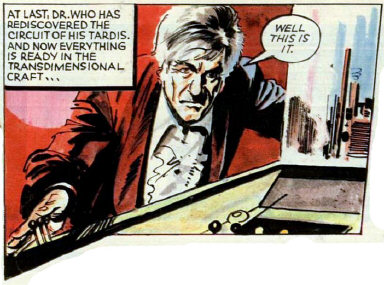 | | | | SCRIPT: Dennis Hooper
ART: Harry Lindfield ISSUES: 15 - 22
COVER DATES: 29 May 1971 - 17 July 1971
ON TV: The Daemons (Season 8), Spearhead from Space (repeat)
REPRINTS: Classic Comics Issue 1, December 1992 (see above) - Classic Comics Issue 2, January 1993 Finally managing to pilot the TARDIS away from Earth, the Doctor materialises aboard what appears to be a colony ship filled with people in suspended animation. However, whilst investigating he is captured by a hovering robot that communicates in Vogan, and the Doctor knows the Vogans to be evil. Believing him to be an escaped sleeper, the robot reprocesses Doctor Who, but he is able to resist the hypnotic processing and escapes back into the ship where he revives a girl named Trandi. She tells him that her people, the Crallicans, faced destruction as Crallica was dying. The Vogans arrived and offered to escort them to a safe world, but the Doctor knows the Vogans will not honour this promise as they enslave whole races to mine a special mineral called Voganite that gives them great longevity. The Doctor traces the Vogans to a planet close to where the ship decelerated and he and Trandi enter a Voganite mine, but they are soon detected by the Vogans and shot down with a laser. The blast gives the Vogans time to capture the intruders, and it soon becomes clear that the ancient, evil Vogans know of the Doctor and his TARDIS and want to use the machine to transport slaves from their ship to the mines as the ship cannot pass through the planet’s atmosphere and the race is doomed without their precious Voganite. The Doctor agrees, but tricks the weakening Vogans. As he dematerialises with Trandi and some Vogan robots aboard, he disables the robots and reprograms them to obey his orders. Landing aboard the ship, he again tricks and reprograms the robot there, then breaks the Vogan’s hypnotic spell over the Crallican people. Landing back on the planet, he leads the Crallicans into the mine and accepts his payment, but he deduces that the Vogans have hidden an explosive device in the valuable minerals. The Doctor delivers this back to the Vogans inside one of his reprogrammed robots and, when they detonate the bomb intending to destroy him and his TARDIS, they blow themselves to pieces instead The planet is now free for the Crallicans to make into their new home. |
| |
|  |  | | ALTERED VISTAS SAYS:
The Doctor’ relies on his ‘old reed pipe’, possibly a reference to the recorder he played during his Second incarnation. The storyline for this strip is perhaps overlong and not exactly inspired, especially after the last two strips, and the Doctor’s assertion that (previously unseen) Mekon-lookalikes the Vogans are evil before we have even seen them, doesn’t help matters. The Crallicans, Trandi included, are a bland bunch with nothing much to distinguish between their hypnotised and un-hypnotised state, though the Doctor is very in character, even if he does refer to his ship as TARDIS, like the early novelisations. The artwork is still very nice, and the likeness of Pertwee’s Doctor especially noteworthy, but the panels, and particularly the colour, are generally slightly less impressive than either of the previous two stories. A note of interest is that the Doctor finally pilots the TARDIS away from Earth for the first time in the comic strips since June 1969’s Operation Wurlitzer. |
|
 |  | | THE CELLULOID MIDAS |
 |  |  | |  |  |  |  |  |  |  |  |  |  |  |  |  |  |  |  |  |  |  | | 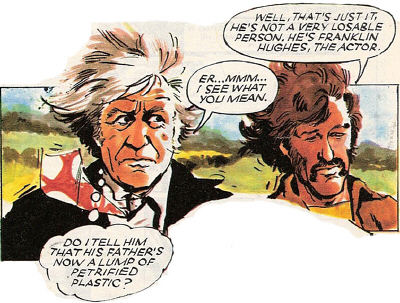 | | | | 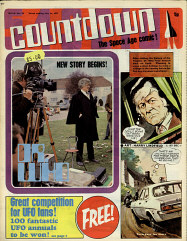 | |  | | | | | 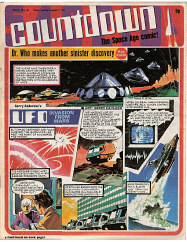 | | 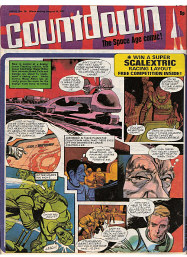 | | | | | | SCRIPT: Dennis Hooper
ART: Harry Lindfield ISSUES: 23 - 32
COVER DATES: 24 July 1971 - 25 September 1971
ON TV: Spearhead from Space (repeat)
REPRINTS: Classic Comics Issue 3, February 1993 On the orders of the Prime Minister, the Doctor is driven to the village of Puddlesfield in Hampshire where a BBC film crew filming a daily drama has been turned into some kind of plastic. A newspaper reporter named Jamie Ferguson steals the film from the TV camera, but later he and his fellow reporters are also found turned to plastic. Luckily the film has not been taken, and Doctor Who studies prints taken from it and notices a strange light in a windmill in some of the shots. Immediately, he drives back to Hampshire, but almost mows down a hitchhiker. The man is unharmed and Doctor Who gives him a lift to Puddlesfield. His name is Denis Hughes and he says he is searching for his father, Franklin Hughes, one of the actors in the BBC drama. Doctor Who decides to not involve him for the moment and asks a local milkman about Danver’s Mill. However, his investigation is observed and the Doctor’s snooping at the mill is curtailed when the milkman starts shooting at him. He disarms the man but finds he too is plastic. Unable to find help in the village, the Doctor drives off, but the evil mastermind behind the scheme decides that he is becoming meddlesome and must be dealt with. The villagers have put sugar in Betsy’s petrol tank, so she breaks down just outside the village. Nobody will help him - apart from Denis Hughes, whose real name is Denis Peters, sent by the Ministry of Defence. However, before they can discuss matters further, they are pursued by hostile villagers and forced to lie low until nightfall. Leaving Denis outside to fetch the army, the Doctor enters the mill, but evil genius Professor Midas - who hopes to use his plastic ray to take control of the country - has set a trap and one of the villagers shoots him with the plastic ray. The Doctor is prepared, though, and bounces the ray back with a reflective gold pendant. He then convinces an unprocessed and terrified villager to accompany him to Professor Midas’ laboratory in Ambleside Hall where he pretends to be under plastic control. When the Professor leaves, the Doctor changes the settings on one of the three existing machines and sends instructions to Denis and the army. Professor Midas, meanwhile, has realised that the Doctor is not under his control, and sends villagers to deal with him, but the Doctor uses the altered gun to return the villagers to normal. Midas still hopes to use the machine at the mill to capture the advancing army unit, but the Doctor instructed the army to polish their tank so the ray bounces back and destroys Midas. | | | | | | | |  | |  | | | | |  | | 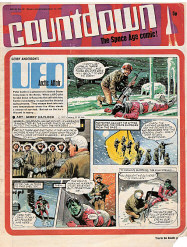 | | | | | | 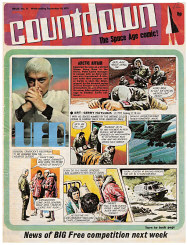 | | 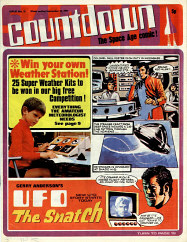 | | | |  | | | | | | |  | | | | | ALTERED VISTAS SAYS:
The strip builds a wonderfully sinister atmosphere in its early parts, but falls apart slightly once Professor Midas’ plans for conquest are revealed. The problem is that the ray really has no need to turn people into plastic, wonderful conceit though it is, and only really needs to control their minds, so things get a little confusing, especially when the Professor’s plan for world domination seems so badly thought out. On the plus side, the Doctor gets to practice some Venusian Karate for the first time in the strip and has some wonderful lines like, “My dear Minister, if you want my assistance on this, I can do without the help of your court jester.” It also has a great title which wouldn’t have seemed out of place in The New Avengers. TV personality Franklin Hughes, by the way, is the spitting image of Countdown editor and Doctor Who strip writer Dennis Hooper, as you can see on the right, presumably a little joke on Harry Lindfield’s part. | | | | | | | 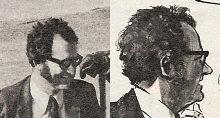 | | | |
 |  | | BACKTIME |
|  |  |  |  |  | | | SCRIPT: Dick O’Neill
ART: Frank Langford ISSUES: 33 - 39
COVER DATES: 2 October 1971 - 13 November 1971
REPRINTS: Classic Comics Issue 3, February 1993 - Issue 4, March 1993 When the Doctor has his pocket picked in London, 1863, by a boy named Charlie Fisher, he soon finds himself sentenced to seven years’ transportation for forgery when he accidentally tries to reward the cabbie who stopped the young thief by giving him a modern bank note. He and Charlie escape the court and run to the TARDIS. The Doctor plans to set Charlie down somewhere safe in his own time so he can start afresh - but the TARDIS lands at Gettysburg in the middle of the American Civil War, and he and Charlie are suspected of being Confederate spies by a Federal general. They are imprisoned awaiting a dawn execution, but the Doctor and Charlie escape. The Doctor thinks the only way to survive is by convincing the General of their loyalty to the Union by sketching the enemy lines, so they steal a hot air balloon and head up into the sky. Unfortunately, they are shot down by Confederate forces. They manage to evade them and steal a steam train, but are eventually forced to jump from a bridge into a river - and straight into the path of a paddle steamer! The steamer is a Federal gunship and the Doctor and Charlie are rescued. The Doctor gives his information to the commander - Abraham Lincoln! Gettysburg is won because of the Doctor’s sketch of the enemy lines, but the Union army makes off with the TARDIS. The Doctor and Charlie follow, but are cornered by George Bamford and his brother Asa, a pair of Confederate desperadoes, who insist on joining them in an attack on the Union camp. However, when the raid succeeds, the men expect their cut of the loot and are unimpressed by the TARDIS. The Doctor offers to take them and Charlie to a new life, but the men are too scared and the Doctor leaves them behind, taking Charlie to a new life in Ballarat, just twelve years after the start of the gold rush. | | | ALTERED VISTAS SAYS:
The art is as good as we’ve come to expect, but the story this time round is frankly a bit of a mess. The Doctor’s decision to sketch the enemy lines from a hot air balloon is a bit odd, as is his decision not to wake the camp by simply stealing back the TARDIS and leaving. Interestingly, the Doctor claims that he always wanted to be an engine driver, something he would repeat on television in Black Orchid eleven years later. Mind you, in this strip he also claims to have built the TARDIS... Charlie is a fairly likeable and well characterised temporary companion, even if his “Lord, luv a duck” speech is at times a little much. | | | 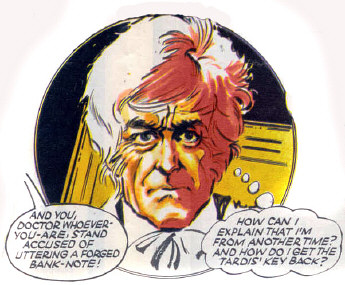 | | 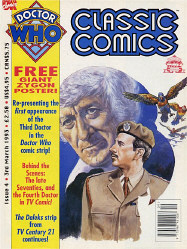 | |
|
 | | |  |
 |  | | THE PLANT MASTER |
 | | |  |
|  |  | | SCRIPT: Unknown
ART: Jim Baikie The Doctor materialises the TARDIS somewhere in the West Country, right in the path of motorbike rider Dave Lester. The Doctor offers him a trip in the TARDIS and Dave chooses to visit the local Carradine Estate where tropical plants are grown, as he senses a mystery there. And indeed there is, for Carradine runs screaming from the house. When he collapses, the Doctor and Dave are discovered by Professor Rayner. They help him get Carradine back into the house, but immediately he turns on them, using a machine to bring the many exotic plants to life and hold them prisoner while he goes to feed the Master-Plant, a sort of plant brain capable of controlling all other plants. The Doctor breaks free of the plants by throwing a bottle of acid at the machine. He, Dave and Carradine race to stop Rayner feeding the Master-Plant the Potion of Power, but they are too late, as the plant turns on Rayner and kills him. It then traps the Doctor and his friends in the lab by animating all the plants on the estate. When it tries to break in, the Doctor uses a type of weed killer he has hastily prepared which causes the plant to outgrow its strength. The Master-Plant dead, all other plants return to normal. | | | ALTERED VISTAS SAYS:
An intelligent plant, capable of controlling all other plant-life, that grows to tremendous size and overruns a large country house? Why it’s The Seeds of Doom five years too soon! Given the tight page count, this isn’t too bad as a jolly little romp and works quite well as an exciting adventure, though the art is a little below par with Jim Baikie never quite capturing Pertwee’s likeness. Rayner, however, bears a striking resemblance to the Master. |
|
 | | |  |
 |  | | THE ETERNAL PRESENT |
| |  |  | | SCRIPT: Dennis Hooper
ART: Harry Lindfield (40-41), Gerry Haylock (42-46) ISSUES: 40 - 46
COVER DATES: 20 November 1971 - 3 January 1972
ON TV: The Daemons (repeat), Day of the Daleks (Season 9)
REPRINTS: Classic Comics Issue 4, 3 March 1993 - Issue 5, 31 March 1993 The Doctor returns to Earth, but he is being pursued through space-time. An alien called Andron materialises on Earth and disguises himself as a village policeman. He then forces the Doctor to allow him access to the TARDIS before revealing that he is head of the Time Police and arresting the Time Lord in the name of Mar-Kom, Lord of New Britain. |
|
 |  | | Temporarily paralysing the Doctor, Andron pilots the TARDIS to Earth in the year 3550 and leaves the Doctor in his cell to await execution. There the Doctor meets Theophilus Tolliver, a fellow from 1897 who invented the world’s first time machine, but who was also caught by the Time Police. The two men are sentenced to trial by combat against a deadly robot. The Doctor is appalled, but even more so when he discovers that the Lord Mar-Kom is an android. However, he and Theo defeat the robot using their scientific knowledge, then destroy the android and escape into New London. Here they discover that all the people of Earth have been frozen in stasis since about 2200 AD. They head to St Paul’s cathedral where the Doctor suspects they will find the real power behind New Britian - a giant master computer. Though the computer sends robots to stop them, the Doctor and Theo race to shut it down by reprogramming its memory banks. They succeed, driving the machine insane, then escape back to their time machines. |
|
 | | |  |
 |  | | COLONY IN SPACE |
|  |  |  | | SCRIPT: Malcolm Hulke
ART: Frank Bellamy COVER DATE: 10 April 1972 - 16 April 1972
ON TV: Colony in Space (Season 8)
REPRINTS: Timeview (1985) Two pages of full colour and one page of black and white illustrate the opening moments of a new Doctor Who story due to start on television that evening. | | | ALTERED VISTAS SAYS:
Gloriously illustrated, if occasionally a touch psychedelic in the colouring, this brief taster of the Third Doctor’s first TARDIS trip away from Earth marks the first comic strip appearance of Jo. | |
| |
 |  | | * SUB ZERO |
| |  |  |  |  |  |  | | | The Doctor and Davis reach the glacier just as the doors open to release the Daleks aboard an armada of vessels collected through the centuries. They gain entry to the base and the Doctor guesses that this is a small company of Daleks who landed centuries ago and who have been waiting for man’s technology to advance to a level where they could use it against them. All radios have been removed from the base and the only means of warning the world is in an ancient seaplane. As it runs out of fuel, the men crash land on a ship. They radio a warning about the Daleks, but it is too late - the Daleks release nuclear missiles and destroy Sydney. They then move in to convert any survivors into Dalek slaves. They then plan to build more Dalek machines and surgically convert humans into Daleks, changing first their bodies, then their minds. The Doctor and Davis get to Australia by plane and then drive into the ruins of Sydney, but it isn’t long before they are cornered by Dalek slaves. They drive through them and locate the centre of Dalek activity, but once inside, the Doctor is recognised by the Dalek Supreme who orders his capture for conversion into a Dalek. The Doctor evades them and, as the submarine containing all of Daleks passes under the ruins of the Sydney Harbour Bridge, Davis throws a live power cable down onto it, which burns out all the Daleks. | | | 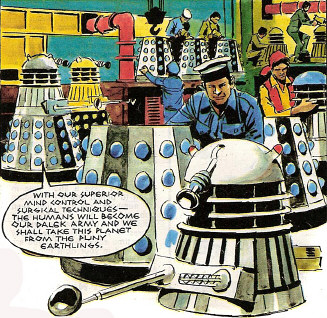 | | | ALTERED VISTAS SAYS:
Let’s get this straight - although this strip builds nicely and the Daleks have seldom looked so good in comic strip form, their plan is frankly rubbish, and how the Doctor knows they’re off to attack Australia is never explained, and the end is rather abrupt. The Dalek plan to convert humans into Daleks is thirteen years ahead of Revelation of the Daleks and unusually grim for a comic strip of this period, especially as the Daleks specify that bodies will be converted before minds. One of the characters (not the Doctor) utters the line ‘Jumping Jehosophat’ (but then he also says ‘Great suffering snakes’ so the guy has clearly watched far too many episodes of Batman). | | | 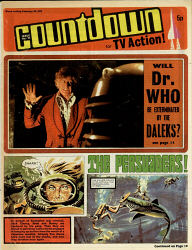 | | | |  | | |
|
 | | |  |
 |  | | THE PLANET OF THE DALEKS |
|  |  |  |  |  |  | | 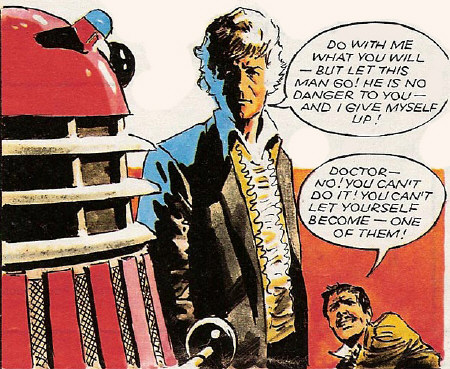 | | | | SCRIPT: Dennis Hooper
ART: Gerry Haylock ISSUES: 55 - 62
COVER DATES: 4 March 1972 - 22 April 1972
ON TV: The Sea Devils - The Mutants (Season 9)
REPRINTS: Classic Comics Issue 6, April 1993 Whilst the Daleks plot their revenge on Doctor Who for defeating their invasion attempt (see above) by setting up a time vector that will trap the TARDIS as soon as it dematerialises, the Doctor has been entertaining some fellow scientists. However, one of them, Finney, is an impostor who wants to steal the TARDIS, but the Doctor saw through his disguise and is waiting for him. Finney’s attempt at tricking the Doctor leads to a fire in the cellar of the Doctor’s cottage and both men are forced to flee in the TARDIS, which is immediately caught in the time vector. Forced down onto Skaro, the Doctor and Finney attempt escape, but our soon cornered by the Daleks. He will be turned into a Dalek via deep hypnosis. Finney, meanwhile, is imprisoned, but manages to escape and find the Doctor. However, it seems he has arrived too late as the Doctor is now the new Dalek leader. | | | 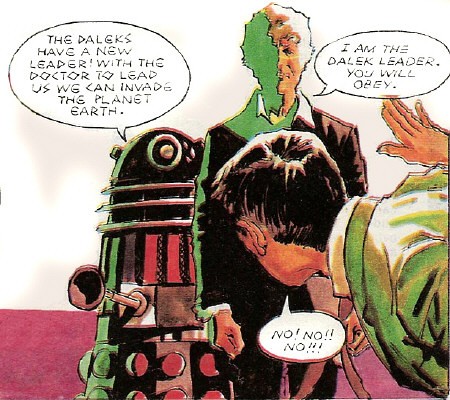 | |
| |
 |  | | With Finney as his prisoner, the Doctor leads the Daleks into the TARDIS ready to begin the attack on Earthj. However, once he is alone with Finney he reveals that it was all a trick to trap the Daleks - he plans to materialise the TARDIS in the heart of the sun. Unfortunately, he decides to forewarn the Daleks and they manage to revert the controls to their previous settings, landing the TARDIS back on Skaro. In the confusion, the Doctor and Finney escape into the jungle, but the Daleks are close behind and the TARDIS is theirs. The fugitives decide to lay a trap, but are soon caught between a triceratops-type monster and the Daleks. They escape whilst the two do battle, but it gives the Doctor an idea, and he and Finney track down a herd of the monsters to lay a trap. However, when the Doctor goes back to the TARDIS to spring his trap, the Daleks have conquered the controls of the TARDIS and no longer need him. Luckily, Finney gets the animals stampeding and the Daleks are destroyed - apart from their leader who is still in the TARDIS. The Doctor and Finney enter, but the Dalek leader resets the controls and takes them back to the time vector. Just as he is about to destroy the Doctor, Finney pushes him into the vector’s metal struts and causes an explosion. The Dalek threat is finally at an end, as is Finney’s stolen ride in the TARDIS. |
| |
|
 | | |  |
 |  | | A STITCH IN TIME |
 |  |  | |  |  | | SCRIPT: Dennis Hooper
ART: Gerry Haylock ISSUES: 63 - 70
COVER DATES: 29 April 1972 - 17 June 1972
ON TV: The Mutants - The Time Monster (Season 9)
REPRINTS: Classic Comics Issue 7, June 1992 After being caught in the blast of a galaxy going nova, the TARDIS arrives on a strange desert planet. He sees a couple of the inhabitants, but they - fearful because he is neither a norm nor a mute - run away. However, he is soon cornered by a guard on a six-legged camel. The guard is a mute and has superhuman strength. The Doctor looks set to lose his fight when the two inhabitants, Gleet and Brod, step in. They take the Doctor to their secret base, but here the Doctor is in for a shock, for the building hidden beneath the sands is the British Museum. The last human survivors of the year 5000 reveal that the Mutes are mutations, but they are prospering while the humans are dying out. However, Brod believes that the Doctor is the only person capable of changing things - in TARDIS. The Doctor agrees and, as the base comes under attack from the warlike Mutes, he and Brod escape back to TARDIS. However, the ship has been captured by the Mutes and is being lifted in a net beneath one of the their airships. The Doctor grabs hold of the net and is taken back to the Mute base, which is in a medieval castle, but is soon captured and taken before the Mute leader who wants to know how TARDIS works. The Doctor attempts escape but is stopped and recovers consciousness aboard an airship, TARDIS dangling beneath it on a rope. The leader demands he draw how TARDIS works or his ship will be destroyed. However, the airship comes into the path of a tornado and the leader believes the Doctor has conjured it. The two men fight, but the leader plunges to his death. Doctor Who makes a daring escape down the rope to TARDIS and cuts it free. He and the ship plunge into the sand mere seconds before the airship crashes and burns. But when the Doctor recovers consciousness, TARDIS has been completely buried in the sand. It turns out that the last humans dragged TARDIS back to their base, and now they take Doctor Who back there. They tell him that the war that devastated Earth originated in the biological experiments of American scientist Theodore Cassells in 1873. The Doctor and Brod travel back in time to ancient New York to try to dissuade the scientist from publishing his discoveries, but Professor Cassells refuses to accept their word. Brod suggests showing him TARDIS, but when they return to the dock where the Doctor materialised, TARDIS is being lifted aboard a ship. The Doctor gets Brod and Cassells aboard then pays the Captain to take them as passengers. However, Cassells is unable to accept the wonders of TARDIS and, driven almost insane, he panics the crew who all evacuate the ship in a lifeboat as a storm begins to build. Cassells goes with them, talking of devils. Suddenly, Brod fades away and the Doctor realises his mission to change the future has succeeded. He surmises that Cassells and the crew must have drowned leaving the ghost ship to sail on alone. What he doesn’t know is that the ship is called the Marie Celeste... | | | 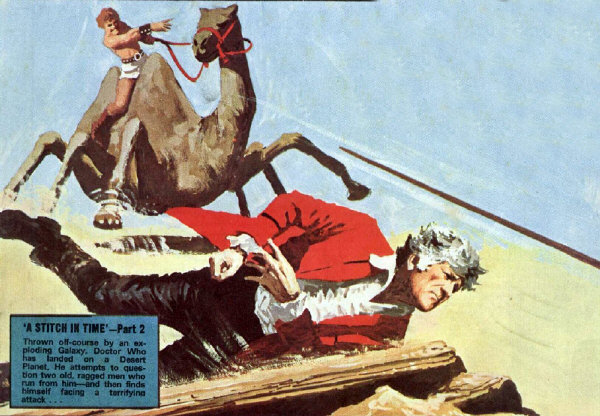 | | | | ALTERED VISTAS SAYS:
There is some inconsistency in the writing of this strip. For example, the last humans at first have no idea who the Doctor is but then reveal that they know all about him from the books in the British Museum’s reading room. The Doctor returns the favour later, calling one of the human survivors Brod even though he’s never been told the man’s name. However, the story is a fairly good one, and the inclusion of the Marie Celeste is a clever idea, even if it does contradict events seen in The Chase. Brod is not as well defined as previous temporary companions, but probably counts as the ugliest assistant the Doctor ever had either in the comic strip or on TV, looking rather like Guffy, the finger-wiggling presenter of 1970s children’s TV show Fingerbobs. | |
| |
 |  | | THE ENEMY FROM NOWHERE |
|  |  | |  | | 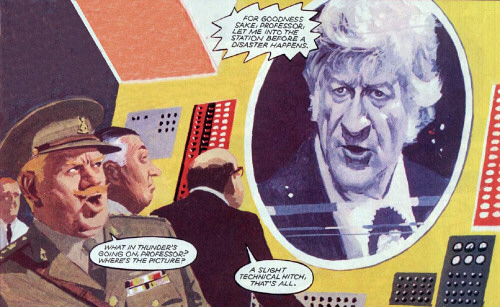 | | | | SCRIPT: Dennis Hooper
ART: Gerry Haylock ISSUES: 71 - 78
COVER DATES: 24 June 1972 - 12 August 1972
ON TV: The Time Monster (Season 9)
REPRINTS: Classic Comics Issue 12, October 1993 Invited to Downphilly tracking station in Cornwall as an observer, the Doctor watches the successful launch of a new US orbiting space platform. The Doctor has been told of mysterious tracks picked up by a fiery young Welsh technician, Davie Jenkins, who has since been dismissed for striking his superior, Weatherall. The Doctor takes Jenkins from the base, leaving Weatherall with a note to pass to the director of the base. Weatherall destroys the note. The Doctor and Davie confirm the fact that, although the approaching object is over a mile in diameter it cannot be seen with optical equipment, and return to the base to speak to the director before inappropriate action is taken by the military. However, both men are refused entry on Weatherall’s orders and the military have already launched missiles from the space platform to attack the object. The Doctor tries to make the military self-destruct the missiles, believing it to be a spaceship, but the Pentagon refuses, and when the Doctor and Sir Ian MacGregor formulate a plan to send the missiles off course they are arrested. The missiles strike their target but have no effect, and immediately the ship counterattacks the space platform. The platform vanishes and the spaceship goes into orbit around the Earth. The Doctor reveals that the ship comes from a negative galaxy, a mirror image world where all atomic structures are reversed. They try to send a message of peace to the ship, but the response is a ray that destroys part of the tracking station. Desperate to avoid further reprisals, the Doctor and Davie race to the TARDIS and materialise aboard the reverse-matter craft. There they discover the space platform unharmed, and also meet the inhabitants of the craft, the mighty Zerons, masters of the universe, strange floating globes that can form themselves into larger entities and who have come to transfer Earth to their reverse matter galaxy. But believing the Doctor insignificant, they do nothing to stop him as he enters the space platform and speaks to the crew. Meanwhile, all countries of the Earth have aimed nuclear missiles at the ship and offered an ultimatum - leave or be destroyed. The Doctor, however, has devised his own bomb from the warheads aboard the station. He leads Davie and the station crew back to the TARDIS and dematerialises. Soon the Zerons begin the procedure to convert the Earth to reverse matter, but the Doctor has rigged his bomb to detonate when the ship increases its power output. It explodes and is joined by the entire nuclear arsenal of Earth, destroying the Zeron ship. The Doctor returns Davie and the crew to Earth and dematerialises, but something immediately takes control of the TARDIS. |
|
|  |  | | ALTERED VISTAS SAYS:
Rather slow in its opening parts and labouring the fact that the UFO cannot to seen, but this strip does build a nice air of menace and mystery by focusing on the politics and internal wranglings within the tracking station. These early parts also feel much more adult as the Doctor tries to mediate a peace. However, the tension and ambiguity is lost once the Zerons and their evil plan are finally revealed, as the shoot-first policy of the Earth politicians is shown to be the correct one after all, and the Doctor’s attempts to avert a war that Earth cannot hope to win are wasted when he builds a ruddy great bomb of his own and blows the evil critters to kingdom come. |
|
| |
 |  | | THE UGRAKKS |
| |  |  | | SCRIPT: Dennis Hooper
ART: Gerry Haylock ISSUES: 79 - 88
COVER DATES: 19 August 1972 - 21 October 1972
REPRINTS: Classic Comics Issue 13, November 1993 - Issue 14 December 1993. |
|
 |  | | The TARDIS is dragged halfway across the universe by the power of the Ugrakks. At the last moment, the Doctor manages to break free and materialise in the planet’s inhospitable jungle of lichen and fungus, but he is soon captured by Fabus the Ugrakk who tries a ruse of friendliness to get the Doctor to accompany him back to the city then, when this fails and the Doctor attempts escape, shows his mastery over the living fungus in the jungle to recapture the Doctor. In the city, which is a giant, living fungus, the Doctor meets Demur, leader of the Ugrakks. Demur proclaims mastery over the Doctor, and when the Doctor refuses to submit, he is thrown into the punishment chamber where fungus spores begin to grow on him. He is forced to cooperate before the spores start to feed. The Ugrakks have mastery over the fungus but their powers are weakening because the fungus is weakening. They want the Doctor, who they know to be a Time Lord, to give them the secret of transmaterialisation so they can move to a new world. Also a captive is Professor Lammers from 20th century Earth, who crashed on the Ugrakk world in his spaceship. It was he who told them about the Doctor. Further discussion is interrupted by an attack of gigantic Zama flies, natural enemies of the Ugrakks. The Doctor and Professor Lammers use the attack to escape the Ugrakk city by clinging to the legs of a Zama fly. However, the Ugrakks use deadly spores to attack the Zama fly and the Doctor and Lammers are forced to jump into the jungle below. Escaping the Ugrakk spores, the Doctor and Lammers enter a cave and tumble down into a Zama fly nest. There they discover that the nest is filled with a substance like nitrate - the whole nest is a potential bomb. Following an underground river, they discover the roots of the Ugrakk city, which are being slowly eaten by Zama grubs. The Doctor tries to get closer as Ugrakks appear to repair the damage, but he is heard. However, throwing a stone to burst the Ugrakks’ protective bubbles exposes them to the nitrate and they die. While the Ugrakks prepare an expedition into the underworld to destroy Lammers and the Doctor, the pair make it back to the heart of the Zama nest where the Doctor causes an explosion which dislodges hundreds of Zama eggs. These float down to the roots of the Ugrakk city, hatch and begin to destroy it far quicker than before. The Ugrakk city begins to tremble, but the Ugrakks are attacked from the air by the Zama flies who wipe them out. Professor Lammers reveals that the Ugrakks were a type of fungus themselves, hence their mastery over the planet’s flora and why the Zama flies attacked them. The planet rid of its evil, he and the Doctor prepare to leave in the TARDIS. |
 | | | 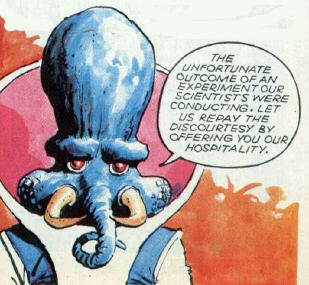 |
 |  | | ALTERED VISTAS SAYS:
This story is the one where, famously, the monster was created by a TV Action reader, that being the Ugrakks by Ian Fairningon. This might be where the problems start, but it’s certainly not where they end. At one point the Doctor cries ‘Take that, you hideous nightmare’ as he lobs a rock at an approaching Ugrakk, which not only feels out of character and probably there more to assure Ian Fairnington that his monsters are indeed hideous, but given that they look rather like elephants they’re patently not in the slightest bit hideous and also not even particularly fungus-like, which makes it hard to accept Lammers statement that the Ugrakks are a type of fungus. We are also supposed to accept that the Ugrakks can create a machine to draw the TARDIS halfway across the universe, but can’t construct a device either to get them off the planet or deal with the Zama flies. Also, how did they construct this device if - as they claim - there are no mineral deposits on the planet? |
 | Most of the story is a slightly plodding voyage of discovery for the Doctor and his new chum featuring very little of the eponymous monsters, who are characterised merely as evil, even though they barely illustrate this as they fight for survival against their planet’s ecosystem. The Doctor wiping them all out at the end feels a little unjust, to say the least. None of this, of course, is a criticism of Ian Fairnington’s creations, and if you’re out there, Ian, then drop us a line!
|
| |
| |
 |  | | STEELFIST |
|  |  | | SCRIPT: Dennis Hooper
ART: Gerry Haylock ISSUES: 89 - 93
COVER DATES: 28 October 1972 - 25 November 1972
REPRINTS: Classic Comics Issue 15, January 1994 Attempting to visit his friend Doctor Trent, the Doctor is just in time to see the man and his son kidnapped. He gives chase in Bessie, but ends up being kidnapped too. He recovers consciousness in the enemy base just in time to see the mysterious General Steelfist and Trent and his son transmatted away. However, before he can act he is bundled into a car which is pushed over a cliff. He makes it out and ashore and is there befriended by a strange old beachcomber called Arnie Babbs. Doctor Trent meanwhile finds himself orbiting the Earth in a satellite. Steelfist tells him he will obey or his son will die. |
 |  | | Babbs leads the Doctor to Point Farm, headquarters of the kidnappers, but then vanishes leaving the Doctor to explore. He soon meets a memeber of Steelfist who attempts to hypnotise him. The Doctor plays along and is soon transported to the satellite and ordered to work alongside Doctor Trent. However, the Doctor is suspicious and soon discovers that the satellite is in fact an old lighthouse and not in space at all. As he and Trent prepare to escape they again meet Arnie Babbs who guides them to safety. The Doctor sends Trent back to Point Farm to find his son while he goes to visit Babbs’ beach hut. Here he finds a trap door and investigates. Babbs was General Steelfist all along, trying to blackmail the world into accepting him as its leader. Babbs uses his transmat to escape and Trent and his son are reunited. |
| |
|
 | | |  |
 |  | | RIDE TO NOWHERE |
|  |  | | SCRIPT: Unknown
ART: Frank Langford REPRINTS: None After having his Rolls Royce serviced at a new garage, Sir Henry Felton, electronics expert who is working on a form of matter transmitter, is driven under police escort for an important meeting with Doctor Who. However, when the car arrives, Felton has vanished. The Doctor also takes a journey in the Rolls, and finds himself transported out if it via matter transmitter to the same place as Felton. They soon meet their host - a peaceful alien from Proxima Centauri in the Crab Nebula who wants to stop the humans from developing matter transmission technology and spreading warfare throughout the galaxy. However, the Doctor left a note in the car alerting the authorities that the source of the matter transmission was the garage, and soon the army move in. Against violence, the aliens depart, but Felton is now aware of the dangers his new invention could pose |
| |
 | | |  |
 |  | | THE ZERON INVASION |
|  |  | |  | | 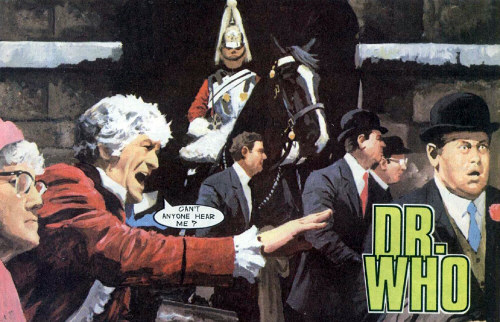 | | | | SCRIPT: Dennis Hooper
ART: Gerry Haylock ISSUES: 94 - 100
COVER DATES: 2 December 1972 - 13 January 1973
ON TV: The Sea Devils (edited repeat), The Three Doctors (Season 10)
REPRINTS: Classic Comics Issue 15, January 1994 - Issue 16, February 1994 The Doctor is attacked by a radiation bombardment from a ship closing fast on Earth. He makes it to the TARDIS which shields him from the blast. The attack over, the Doctor heads for Whitehall intent on warning the Ministry of Defence that a ship is approaching, but discovers that the population has been placed in a trance by the same bombardment. But one man has escaped - American tourist Nick Willard spent the night locked in an underground station after missing the last train. The Doctor explains to him that the people have had their brains neutralised and thus repeat the pattern of the day before over and over. The Doctor and Nick head to the Post Office Tower and broadcast a signal that shocks the population from its trance. However, they are then arrested by the police for causing thousands of pounds worth of damage, and the police remember nothing of being neutralised and will not accept their story of alien invasion. However, the story soon gets out to the Press and the Doctor and Nick end up in Whitehall and then Downing Street where their story is taken more seriously, but the cabinet still decide to wait and see what the craft intends. Desperate to get the people to safety, the Doctor goes to a radio station where Nick’s cousin, Jed Felix, is a DJ. Jed allows them to broadcast a warning to the people, and many take cover in the underground stations. However, the aliens realise the neutraliser has been reversed and activate it again. Jed is rendered unconscious by the blast and everyone not in the underground is sent back into their trance. The Doctor and Nick get to the underground with Jed where the Doctor sends the survivors deep into the tunnels. He then plans to turn the electrified rails into a force field to cancel the effect of the neutraliser. But the Zerons are aware of the rogue element and activate the controlled Jed to kill the Doctor. Nick saves the Doctor’s life. In the fight, Jed touches a live power cable and is knocked out. When he recovers, he is free of control. The Zerons realise this and activate other neutralised humans to destroy - a squad of commandos. Nick and Jed try to delay them by starting a fire on one of the underground trains, but the commandos break through. Nick and Jed race back to the Doctor as he activates his forcefield device, freeing the neutralised men. The Zerons, aware of their defeat, apply maximum power to neutralise the rebels, but the Doctor’s forcefield repels the blast and bounces it back to the Zerons who are miniaturised and rendered harmless. |
|
 |  | | ALTERED VISTAS SAYS:
Nick Willard is the first black Doctor Who companion - official! Long before Sharon, Mickey Smith or Martha Jones, Nick Willard was fighting aliens and asking ‘What is it, Doctor?’ This story is fairly good, though why the Zerons (no relation to the Zerons from The Enemy from Nowhere) don’t attempt another plan that doesn’t involve their neutraliser is anyone’s guess, particularly as they are clearly highly advanced. It also isn’t clear why the Doctor and Nick remain unaffected when the Zerons reactivate the neutraliser, nor why, when the Zeron ray bounces back on their ship, it also miniaturises them, but these are minor points in an enjoyable story that has plenty of excitement and some very nice visuals. |
| |
 | | |  |
 |  | | DEADLY CHOICE |
 | |  |  |  |  |  | | SCRIPT: Dennis Hooper
ART: Gerry Haylock ISSUES: 101 - 103
COVER DATES: 20 January 1973 - 3 February 1973
ON TV: The Three Doctors - Carnival of Monsters (Season 10)
REPRINTS: Classic Comics Issue 18, March 1994 The Doctor is invited, along with many other eminent scientists, to attend a function held by the Society of Earth’s Friends at Charlemagne Hall, one of many being linked by television around the world. Their host is the sinister Abbot of Mai’Sung, and he immediately proposes for the good of humanity the removal of meddling scientists from the world, then puts it into practice by activating nerve gas. The gas puts all the scientists into a deep coma, apart from the Doctor who quickly recovers. They will all die if Mai’Sung doesn’t treat them within forty-eight hours. He demands they all be loaded aboard a plane and sent to him, and the Doctor goes along to stop the fiendish mastermind. Once there, the Abbot offers him joint leadership of the world, but the Doctor tricks him and blows up his base. | |  | | | 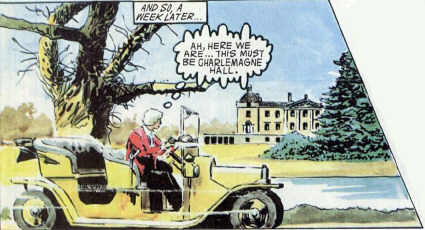 | | | | | | ALTERED VISTAS SAYS:
Deeply unsatisfying on so many levels, the final instalment feels rushed and under-explained, the whole thing feels more like an Avengers plot than a Doctor Who story and the art has a hurried feel to it, quite at odds with Gerry Haylock’s usually accurate and detailed work. | | | |
 |  | | WHO IS THE STRANGER |
|  |  | | SCRIPT: Dennis Hooper
ART: Gerry Haylock ISSUE: 104
COVER DATE: 10 February 1973
ON TV: Carnival of Monsters (Season 10)
REPRINTS: Firstly reprinted in Mighty TV Comic’s Doctor Who Winter Special 1977, with Jon Pertwee’s likeness replaced with Tom Baker’s (see here), then in Classic Comics Issue 19, April 1994 The TARDIS drifts back on a time beam to 1940s France where the Doctor is quickly arrested by the Gestapo. Threatened with torture if he doesn’t talk, the Doctor puts himself into a self-induced trance. He is taken to Professor Schmidt at a nearby chateau who thinks him a perfect specimen for his new truth serum, but when the Doctor awakes he switches glasses with Schmidt and Schmidt drinks the serum instead. From him the Doctor learns that the Nazis plan to crush the Reynard resistance group by using a spy they have concealed in their ranks and, convincing Schmidt that he is a high ranking German official, leaves the chateau. He goes immediately to the village and contacts the resistance, but they are dubious about him and test him before trusting him and his information. By radioing a message to London demanding the chateau be bombed they expose the traitor but are arrested and returned to the chateau. However, the Doctor frees them and takes them to Professor Schmidt who is forced to help them trick the General by saying that the message was never sent to London. Soon after the chateau is bombed. |
| |
 |  | | THE GLEN OF SLEEPING |
|  |  |  |  |  |  |  |  |  |  | | SCRIPT: Dick O’Neill
ART: Gerry Haylock ISSUES: 107 - 111
COVER DATES: 17 February 1973 - 31 March 1973
ON TV: Carnival of Monsters - Frontier in Space (Season 10)
REPRINTS: Classic Comics Issue 20, May 1994 Whilst fishing in the Highlands of Scotland, the Doctor meets archaeologists Professor Barnes and Doctor Sanders who are investigating the Glen of Sleeping, the legendary resting place of Red Angus and his men who, it is said, wait in sleep for the next Stuart prince. One of them discovers a set of bagpipes in a cave. Despite the Doctor’s protests, Doctor Sanders blows the pipes and summons Red Angus’ army from its slumbers before revealing himself to be the Master. The Doctor escapes the Master and his army by causing a cattle stampede, then returns after nightfall to rescue Professor Barnes and his men, but Barnes has been abandoned: the Master and his army have gone to Loch Morag, location of a US Navy submarine base where they seize the USN Gettysburg, a nuclear submarine. The Doctor meanwhile investigates the cave where Red Angus and his army slept and realises that it has been converted into a time trap using advanced machines called chronons, either by the Master or some other time traveller. The Doctor takes the two chronons, hoping to use them to thwart the Master’s plans. The Master broadcasts his demends: either the Doctor’s TARDIS is handed over to him or he will use the Polaris missiles aboard the submarine to destroy every major city in Britain. The Doctor goes to a nearby NATO base to try to dissuade the ministers there from attacking the submarine with a B-52. They give him just two hours. He and Barnes set the chronons up beneath a bridge on the river then lures the submarine beneath it. Both the Doctor’s boat and the submarine are transported back to 1745 where they immediately come under Redcoat fire. The Doctor and the Master join forces to escape back to the 20th Century. First they scuttle the submarine then head off to the Glen of Sleeping. However, en route they are cornered by Redcoats who have taken Red Angus and his men prisoner and forced them to reveal where the Doctor and the Master might be heading. The Master attempts to trick the Redcoats by claiming to be an agent of King George, but his plan backfires when Red Angus’ men apologise to their master for giving him away. In the confusion, the Doctor slips to the cave and uses the chronons already installed there as a bridge to cross to the 20th Century, leaving the Master to the mercy of the Redcoats. | |  | | | | | 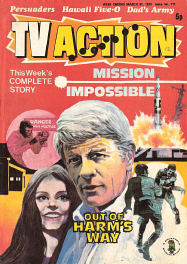 | | | | |  | | | 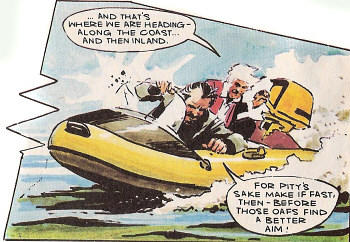 | | | | | | ALTERED VISTAS SAYS:
This is something of a return to form for the comic strip, with - surprisingly - the Master’s first comic strip outing. As the Master’s plans go, this one isn’t too outrageous, though the exact nature of the chronons seems to change from something creating stasis to something acting as a time bridge. Of course, the fact that the Doctor gets back to the present and Angus and his men never enter the cave means that the Doctor never had to travel back in time in the first place, thus creating a temporal paradox. | | | |
|
 |  | | THE THREAT FROM BENEATH |
|  |  | | SCRIPT: Dick O’Neill
ART: Gerry Haylock ISSUE: 112
COVER DATE: 7 April 1973
ON TV: Planet of the Daleks (Season 10)
REPRINTS: Firstly reprinted in Mighty TV Comic’s Doctor Who Winter Special 1977, with Jon Pertwee’s likeness replaced with Tom Baker’s (see here), then in Classic Comics Issue 23, August 1994 The Daleks destroy a series of automated tracking satellites in orbit around the Earth. The East blames the West and the West blames the East, and whilst the situation reaches boiling point, the Daleks land their saucer beneath the sea where they set up a base. The Doctor, meanwhile, is summoned to an important meeting in a bunker beneath Whitehall. Here he debunks a theory about a malfunctioning Russian satellite and states his own theory that the satellite was destroyed by aliens. Using data from a radio telescope he is able to pinpoint where the aliens might have landed. The navy launches a submarine to investigate but the Doctor uses the TARDIS to land aboard the saucer. Here he realises the Daleks are behind things. The Daleks detect the approaching submarine and place its crew under mind control, telling them to report back with negative findings, but the Doctor causes a smokescreen diversion and orders the crew to fire Polaris missiles at the saucer. He races back to the TARDIS as the missiles fire, destroying the saucer and ending the threat to Earth. |
| |
|
 |  | | KCAB TO THE SUN |
 |  |  | |  |  |  |  |  |  | | 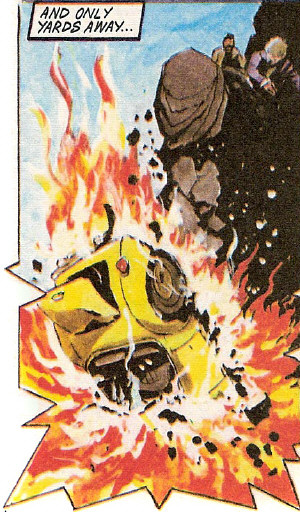 | | | | SCRIPT: Denis Hooper
ART: Gerry Haylock ISSUES: 116 - 119
COVER DATES: 5 May 1973 - 26 May 1973
ON TV: Planet of the Daleks - The Green Death (Season 10)
REPRINTS: Classic Comics Issue 24, September 1994 On a desolate Cambrian mountainside sits Station 40, a revolutionary solar energy source for the whole country, though the locals have protested about it and there are ructions between project director Sir Nigel Lomax and his deputy Roger Perritt over safety issues. The ministry send in the Doctor and ministry man Peter Tait when Perritt makes a formal complaint. After a demonstration of the solar equipment, the Doctor is in agreement with Perritt - the equipment could be highly dangerous, but what neither man knows is that Lomax is in league with aliens who consider the Doctor a threat - he must be killed. While Peter Tait returns to London to continue his investigation, the Doctor stays on in Wales and goes with Perritt to investigate the rocks above the station. Here he discovers that the rocks are volcanic in origin. However, Lomax attempts to kill them both by pushing Perritt’s car over the cliff where the men are working. Neither are harmed. Later that day, the Doctor receives a call from Tait - until ten years ago, Lomax was a noted geologist specialising in volcanoes. However, on an expedition in South America, Lomax entered an active volcano but was caught in an eruption. Miraculously, he escaped several days later, but he has never spoken of the incident since, though it appears he believes that volcanoes house a hostile alien life form. The next day, Lomax tests the solar equipment, but he has also paid some of the locals to stage a riot outside. This is just what he needs to have the place evacuated of staff, however the Doctor remains behind undetected as Lomax lowers the defence shields and plans to use his equipment to create a new volcano in Wales. This will start a chain reaction, transforming the world into a planet of fire ideally suited to the alien life form that Lomax is working with. But Lomax’s paid mob are too thorough and start demolishing the solar dishes which ends Lomax’s plan. The aliens retaliate by killing Lomax. The affair is at an end. | | | | | 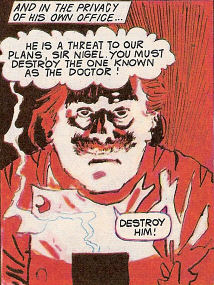 | | | | | | |  | | | ALTERED VISTAS SAYS:
This story actually works better if you think of it as a sequel to Trial of Fire (TV Comic 985 - 991, see here), though I’m sure it was never intended as such. The obsessive Lomax who will stop at nothing to see his plan succeed recalls Professor Stahlman from Inferno, whilst a new source of energy in the Welsh valleys recalls The Green Death, which was on television as this strip was printed (surely a coincidence). There’s nothing much wrong with this strip, but it does feel a little lightweight and underdeveloped and could have done with a couple more instalments to ramp up the danger and make it feel considerably more substantial. | | |
| |
 | | |  |
 |  | | FOGBOUND |
|  |  | | SCRIPT: Unknown
ART: Frank Langford COVER DATE: May 1973
ON TV: Planet of the Daleks - The Green Death (Season 10) Using alien mist flowers from the planet Sarkan, the Master lures the Doctor to the seaside town of Tadcaster by shrouding the resort in a dense mist. The Doctor is effectively blinded by the fog, something the Master takes great delight in, but the Doctor has brought along his blind friend Joe. They pursue the Master to his hideaway at the end of the pier and, desperate to stop the mist flowers from blooming, the Doctor and Joe use the pier train to topple the flowers into the sea where they can do no more harm. |
| |
|  |  | | ALTERED VISTAS SAYS:
A simple little story with some nice and extremely accurate visuals (clearly taken from series photographs) that makes good use of its seaside location. This is the second and last appearance of the Master in the regular contemporary comic strip, and he is characterised fairly well, although only seen clearly in two of the strip’s panels. |
|
 |  | | SECRET OF THE TOWER |
|  |  | | SCRIPT: Unknown
ART: Alex Badia COVER DATE: May 1973
ON TV: Planet of the Daleks - The Green Death (Season 10) The Doctor, UNIT and the Brigadier are on the trail of Hingrad, the universe’s greatest criminal and a master of disguise and have tracked him to a late night underground train. They get the right man but he escapes from them, but the Doctor soon tracks him down again and - expecting an escape attempt - pours a radioactive chemical over his shoes. He and the Brigadier follow the luminous footprints |
|
 | and track him to his lair beneath the Tower of London. The Brigadier goes on to warn the Tower whilst the Doctor slips inside, but Hingrad is waiting for him and traps him in a pair of medieval stocks with a canon pointed at his head. He plans to steal the Crown Jewels which he believes will put him in charge of the world. However, the Doctor escapes and thwarts Hingrad leaving him hiding in the Thames. |
| |
 |  | | ALTERED VISTAS SAYS:
If Fogbound has nice and extremely accurate visuals, this strip is the opposite with messy art and a not a single even half-good likeness in any of its frames. If Fogbound has a simple little story, this barely has a story at all. Quite why Hingrad thinks possessing the Crown Jewels will put him in charge of the world is anybody’s guess, and the ending is open-ended and unsatisfying. Point in its favour? Captain Yates receives his only contemporaneous mention. |
 |  | | THE LABYRINTH |
 |  | | SCRIPT: Dick O’Neill
ART: Gerry Haylock ISSUE: 120
COVER DATE: 2 June 1973
ON TV: The Green Death (Season 10)
REPRINTS: Firstly reprinted in Mighty TV Comic’s Doctor Who Winter Special 1977, with Jon Pertwee’s likeness replaced with Tom Baker’s (see here), then, more traditionally, in Classic Comics Issue 25, October 1994 |
| |
 |  | | Discovering that the Marlenial elements aboard the TARDIS are badly eroded, the Doctor dematerialises in search of Marlenium. However, the ship is caught in a Gallactic storm (sic) and when the Doctor regains control he realises the only source of Marlenium close enough for him to reach is a planet whose sun will soon go nova. The Doctor has almost located some Marlenium when he is seized by a giant ape which takes him to the ruins of a civilisation. However, once here, the Doctor realises that there is still life on the dying planet as he is confronted by a strange face that tells him it is forbidden to walk on the surface. He is sentenced to trial by combat against a warrior named Montax, and if he wins he will also win a girl named Vela. Getting the upper hand and preparing to kill the warrior, the Doctor is astonished when both Montax and Vela disappear. He passes several more challenges before being confronted by the strange face again. It informs him that he has proven himself brave and honest and asks for his help in transporting the children of the native race to a new home. This the Doctor does, but when he goes to repair the Marlenium elements he finds they have been repaired by the Time Lords who engineered the whole mission. |
|  |  | | ALTERED VISTAS SAYS:
This is the least well known of the Big Story strips, and deservedly so as it is little more than a string of largely illogical clichés. Exactly where does the oversized ape fit into the strip? The Doctor wonders how it can breathe the poisonous atmosphere but this is never explained. It also feels very wrong when the Doctor makes to spear Montax rather than sparing his life, and how does this action (plus walking across a pit of fire) prove his bravery and honesty? It seems the TARDIS travels like a conventional spaceship in this story (perhaps because of the eroded Marlenial elements?) as it takes him many weeks to reach his destination. In fact, possibly the only good part of the whole story is the ending, when it is revealed that the Time Lords engineered the mission all along. |
|
| |
 |  | | THE SPOILERS |
 | | |  |
 | | | 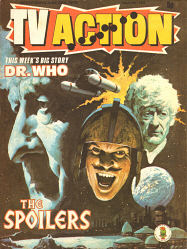 | | | ALTERED VISTAS SAYS:
This story actually fits the seven page length quite well without feeling particularly hurried or shallow, and Soton’s plan to trick the Time Lords is a neat one, even if it doesn’t fool either them or the Doctor for one moment. The Doctor’s solution to the problem is also rather neat. This strip features Time Lords for the first time in the Third Doctor strip, and they are quite unlike those seen in the TV series during this period! |
|  |  | | SCRIPT: Dick O’Neill
ART: Gerry Haylock ISSUE: 123
COVER DATE: 23 June 1973
ON TV: The Green Death (Season 10)
REPRINTS: Firstly reprinted in Mighty TV Comic’s Doctor Who Winter Special 1977, with Jon Pertwee’s likeness replaced with Tom Baker’s (see here), then in Classic Comics Issue 27, December 1994 In Galaxy 593, the twin planets of Raffar and Farraf both support humanoid life, but whilst the Rafs are peaceful and live in a paradise, the Fars are warlike and power hungry and plan to bomb and invade Raffar. However, Far leader Soton is a worried man - the mineral deposits of his planet are spent and only a successful attack on Raffar will keep his people from revolting. But they have insufficient energy to launch the attack, until chief scientist Venin hatches a plot to dupe someone from a higher race into helping them. They send a message which is received by the Time Lords, and soon the Doctor is dispatched to Farraf. He is greeted by Soton in disguise who tells him a tale about how their forefathers wrecked their world, but the Doctor is suspicious and that night breaks out of the cell he has been placed in to follow Soton. He discovers an underground city gearing up for war. Entering the missile bay, the Doctor tampers with one of the missiles and triggers its launch before he is captured by Soton’s men. Soton demands the Doctor take a small party to Raffar to destroy the force field that surrounds the planet or he will be tortured into submission. The Doctor agrees. However, aboard the missile that he launched he also concealed a small transmitter that forewarns the Rafs of attack, and when the TARDIS materialises it is surrounded and Soton and his men arrested. The space invasion then fails to penetrate the force field and the Far race is doomed. |
| |
 |  | | THE VORTEX |
|  |  |  | |  |  | | 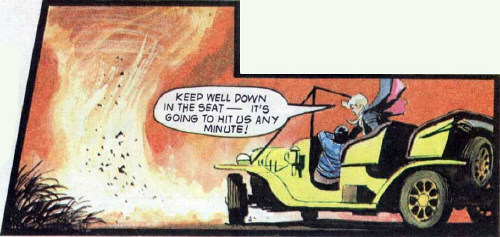 | | | | SCRIPT: Dennis Hooper
ART: Gerry Haylock ISSUES: 125 - 129
COVER DATES: 7 July 1973 - 4 August 1973
REPRINTS: Classic Comics Issue 27, December 1994. Whilst going bird watching in Betsy, the Doctor and young Tom Phipps, son of naturalist Brian/John Phipps, are caught in a strange tornado. When the tornado subsides, he is keen to get Tom home, but his whole house has vanished. Luckily his parents are safe. The Doctor surmises that the tornado was not natural and searching for something, probably himself, so that night he camps out in a tent. His suspicions are proven correct when the tornado returns, but Tom has come to see if the Doctor is safe, and both are swept up by the unnatural force and delivered to an alien world. Tom and the Doctor are tested with visions of beautiful gardens and giant two-headed snakes, but eventually meet their real host, a giant eye on a stalk, which imprisons them in a strange alien zoo. The Doctor and Tom fake food poisoning to escape. The Doctor realises they have been collected by a biological computer and finds the controlling glands. Using Tom’s pen knife, he reverses the gland inlets, which returns them to Earth. The other specimens will be returned before the strange alien vessel returns home. | | | ALTERED VISTAS SAYS:
This strip starts quite promisingly, but seems to fall apart once the Doctor and Tom have been abducted. It feels hastily written and with little sense of logic. The solution also feels hurried and unsatisfying. Bessie is back to being called Betsy - and for the first time in the strip, the Doctor says the name. In fact, names are something of a problem in this strip, as Tom’s father changes his name from Brian in the first part to John in the second. The Doctor also refers to light years as a measurement of time rather than space. | |
| |
 |  | | THE UNHEARD VOICE |
 |  | | SCRIPT: Unknown
ART: Gerry Haylock ISSUE: 131
COVER DATE: 18 August 1973
REPRINTS: Firstly reprinted in TV Comic’ Holiday Special 1978, with Jon Pertwee’s likeness replaced with Tom Baker’s (see here), then in Classic Comics Issue 27, December 1994. A new sonic weapon aboard a satellite malfunctions and cannot be switched off. The only way to stop mass destruction on Earth is to raise the frequency above the level of human hearing. Fearing the worst, the Doctor lands the TARDIS on an island in the North West of Scotland and ventures on foot to the research station responsible for the testing of the new weapon. However, his warning that the sound wave is upsetting the natural order is not believed by Colonel Higgs and he is accused of being an alien spy. The sound wave, meanwhile, begins to cause chaos as animals and birds turn on humans all around the world. As the satellite orbits once more above Scotland, the research centre is attacked by birds and only the Doctor’s quick thinking saves the staff. The self-destruct fails to work so the Americans launch a missile to destroy the satellite, but the sound wave scrambles its guidance systems and causes it to miss. Finally forced to trust the Doctor, Colonel Higgs allows him to go back to the TARDIS, materialise it in space close to the satellite and beam the self-destruct code across thus destroying the satellite and ending the animal aggravating sound. | | | ALTERED VISTAS SAYS:
For once, the Brigadier and UNIT get a name check, though a fat lot of good it does the Doctor. For once with a Big Story, there is probably too little plot here to sustain its length, and Colonel Higgs’ suspicions about the Doctor merely delay the story’s inevitable end. It’s not a bad little tale, though, just rather lightweight, a sort of reworking of Hitchcock’s The Birds, with added explanation and greatly reduced suspense. |
| |
 | | |  |
 |  | | CHILDREN OF THE EVIL EYE |
 | |  |  |  |  | |  |  |  |  | | | 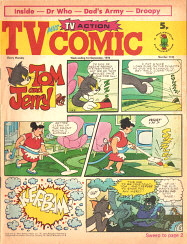 | | | |  | | 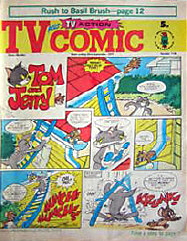 | | | | | |  | | 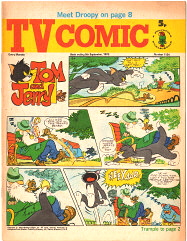 | | | | | | | SCRIPT: Unknown
ART: Gerry Haylock ISSUES: 1133 - 1138
COVER DATES: 1 September 1973 - 6 October 1973
ON TV: Day of the Daleks (edited repeat)
REPRINTS: None After repairing the TARDIS, the Doctor is flung into the 32nd Century - possibly at the behest of the Time Lords. Here he has to save himself and the TARDIS from automated harvesting equipment, but is quickly arrested as an Ancient and discovers that the world is run by children - children who quickly condemn him to death. On his way to the disintegration chamber, the Doctor sees adults working as slaves. Meanwhile, his TARDIS has attracted the attention of the children, though they cannot gain access. In his cell, awaiting execution, the Doctor quizzes his gaoler Arnold. He learns that Oswald is leader of the children, a super-intelligent child who invented many brilliant things. It soon became apparent that the world was the wrong way round and the children revolted. Oswald then arrested the children’s growth to keep them forever young. He also has given the children ‘the gift of the Eye’. The Doctor wins Arnold’s confidence and the two escape, but are immediately captured. Arnold is taken to be severely punished while the Doctor is taken to meet Oswald, who wants the secrets of the TARDIS. However, Oswald refuses to believe the Doctor’s story and subjects him to the full power of the Eye, the machine behind Oswald’s power. The Doctor is apparently killed, but Oswald is forced to overload the Eye’s power to achieve this. Fearful that his position could be at risk, he plans to repair the machine in secret. However, the Doctor placed himself into a trance to survive the Eye’s power and, once recovered, goes to stage a revolt amongst the enslaved adults. He then goes to stop Oswald completing his repairs, almost convincing him that he is a ghost. With Oswald’s power at an end, the Doctor decides to deposit him on a planet where his IQ will be only average. Arnold comes along for the ride. | | | | | 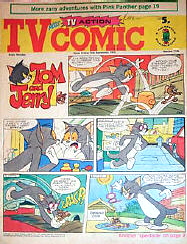 | | | | | |  | | | | | | 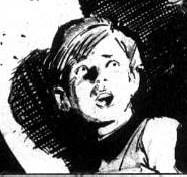 | | | | | | | ALTERED VISTAS SAYS:
After a run of frankly mediocre strips, you might expect things to get worse when the name TV Comic reappears on the masthead, but Children of the Evil Eye is actually a very good story with enough depth, substance and backstory to push it in to the winning league. At the end, the adults are keen to punish Oswald, but the Doctor placing the blame firmly on their shoulders and deciding to relocate Oswald instead is a very Doctor-ish touch that also helps to elevate the strip. Arnold has little character, to be fair, and his decision to take a trip in the TARDIS is perhaps a little forced and too obvious a device for introducing a child identification figure into the strip. | | | 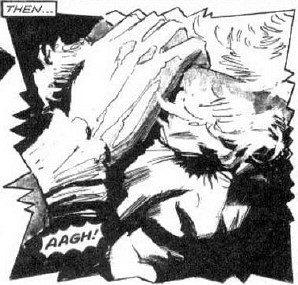 | | | | | IMAGINARY FRIENDS - ARNOLD Child of the 32nd Century (or 31st if you believe The Amateur), poor Arnold receives little in the way of characterisation - in line with other children in the strip around this time, such as Tom Phipps and Peter Trent. He is clearly of above average intelligence, knowing what a supernova looks like, and saves the Doctor from being eaten by a pterodactyl by throwing an extremely well-aimed rock at it. On the plus side, Arnold’s youth clearly brings out the third Doctor’s avuncular nature and the two characters do actually work rather well together for what little time they are in each others company.
| | | | | | |
 |  | | NOVA |
 | | |  |
 |  | |  |  |  |  | | SCRIPT: Unknown
ART: Gerry Haylock ISSUES: 1139 - 1147
COVER DATES: 13 October 1973 - 8 December 1973
REPRINTS: None Having deposited Oswald on some distant planet, the Doctor and Arnold are making the return journey when they spot some sinister spaceships heading into a supernova. The Doctor attempts to warn them but is repaid with a rocket attack that damages the ship and threatens to plunge it into the same supernova. However, when the temperature aboard the TARDIS fails to rise, the Doctor begins to doubt that it is a supernova, and his suspicions are proven correct when they enter a hidden solar system. They land on a primitive world and are forced to shelter in a cave from an attacking pterodactyl. Exploring the cave, they see one of the sinister ships enter and descend into an underground space port. Climbing down what appear to be ropes, they soon discover they are on a gigantic spider’s web, and soon captured by their bizarre spider-like hosts and presented to their leader. He reveals that they are Spidrons, and he is the only intelligent being, the others being mindless drones. His survival is vital to the survival of the species, so to keep his intelligence from ageing they abduct alien species from other worlds. The Doctor and Arnold escape, but soon find themselves on the surface again hunted by Spridrons and threatened by a dinosaur. Luckily it finds the Spidrons tastier than the time travellers. However, soon they are attacked by another dinosaur and Arnold is knocked unconscious. They are saved by a tribe of primitives who imprison them in a cave where they see strange cave drawings predicting that they will defeat the Spridrons. They win the confidence of the tribe, build weapons and attack the Spidron city, destroying it completely. | | | | ALTERED VISTAS SAYS:
After a strong opening, the artwork for this strip becomes uncharacteristically sketchy, and unfortunately so does the narrative, perhaps suggesting that this story was written very close to the deadline. The opening is fairly strong, the middle section with the dinosaur attacks is nothing more than shameless filler, and the ending is rushed and unsatisfying in its brevity. Perhaps the most notable element of this strip is the Spidrons themselves, who are a striking mix of spider and Treen, and the images of the Doctor and Arnold bound up in webs and their subsequent confrontation with the Spidron leader are remarkably similar to images the audience would later see on television in Planet of the Spiders. | | | | 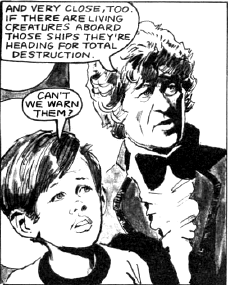 | | | | 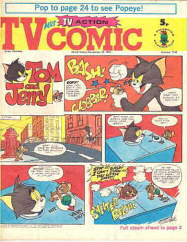 | | |
| |
 | | |  |
 |  | | THE TIME THIEF |
|  |  | | SCRIPT: Unknown
ART: Steve Livesey REPRINTS: None For the third time in as many months, a U.N. ship taking radioactive isotopes and electrical equipment to a nuclear power station in the Antarctic is attacked by war machines from other eras. The Doctor and Jo are called in by UNIT to investigate, and they dive down to the wreck of the U.N. ship where they see some strange men. They give chase but the men flee inside a force field, leaving the Doctor and Jo to be attacked by a giant Ekayprian sea monster. Escaping the monster and penetrating the force field, the Doctor and Jo find themselves transported to the planet Ekaypia where they are soon captured by the Ekayprians. The Master has hypnotised them into making him their leader, but the Doctor hypnotises their guard in the same way, switches the circuits in the matter transporter then escapes with Jo. When the Master switches on the transporter to send his army to Earth, the machine explodes, ending the Master’s plan. |
| |
 |  | | ALTERED VISTAS SAYS:
The plot is rather threadbare and distinctly rushed towards the end, but for an annual comic strip, this isn’t actually too bad and boasts some very nice artwork. The alien world of Ekaypia looks like it might be twinned with Lakertya. It is a real surprise to think that this is Jo Grant’s first appearance in a comic strip, and the Brigadier’s first appearance in a good seven months. |
 |  | | MENACE OF THE MOLAGS |
|  |  | | SCRIPT: Unknown
ART: Steve Livesey REPRINTS: None A spaceship hovers over the Houses of Parliament and drains energy from the world. Similar ships hover over other major cities around the Earth. The Doctor wants to make contact but the PM has forbidden it. However, the aliens soon contact mankind, demanding that all marine and nuclear research stop immediately and the laboratories be turned over to the aliens. They have five days to comply or the world will be destroyed. The Doctor and Jo take a helicopter to talk to the aliens. They are peaceful and come to stop the spread of Molag seeds, which grow into huge creatures that can destroy a planet. However, the aliens resemble the devil and the people of Earth are thrown into a panic. It is left to the Doctor and the aliens to stop the Molags as they turn into rampaging monsters. As they depart, their job done, the aliens hope that one day the Earth may be ready for a constructive relationship. The Doctor hopes so too. |
|
 |  | | ALTERED VISTAS SAYS:
That the aliens look like the devil immediately evokes memories of Azal and the Daemons, but it is a neat twist that these aliens turn out to be peaceful. Jo’s watch stops, cars will not start and lights fail, but the tannoy continues to operate just fine. The reactions of people around the world are amusing in their aptness. This strip isn’t bad, but it isn’t amongst the best either. |
| |
 | | |  |
 |  | | THE HUNGRY PLANET |
|  |  | | SCRIPT: Unknown
ART: Jim Baikie REPRINTS: None TARDIS is dragged down onto an inhospitable planet that does not appear on the Doctor’s star charts. There the Doctor meets Harry Trent, first mate of space freighter ‘Ganelon’ from Aldebaran. The Doctor soon realises that the planet is alive, and his theory is proven when they are chased by a giant tentacle and only saved by a huge pink amoeba, a parasite that lives on the planet’s surface. They escape by allowing themselves to be swallowed by an amoeba, which is then eaten by the planet. Taken down inside the planet they are able to rescue the TARDIS and pilot it to the creature’s heart, which they destroy, ending its threat forever. |
| |
 |  | | ALTERED VISTAS SAYS:
This strip has potential and a clever way of returning to the TARDIS, but it also has some fairly horrible artwork, and the Doctor’s decision to destroy a planet-sized creature simply for doing what it does naturally feels quite wrong, even if the Doctor does make a little speech at the end about how sad it all is. The Doctor’s cry of ‘Great Venusian vegetables!’ must count as one of his strangest comic strip utterances. |
 |  | | THE AMATEUR |
|  |  | | SCRIPT: Unknown
ART: Gerry Haylock ISSUES: 1148 - 1154
COVER DATES: 15 December 1973 - 26 January 1974
ON TV: The Time Warrior - Invasion of the Dinosaurs (Season 11), The Green Death (edited repeat)
REPRINTS: Reprinted in TV Comic Issues 1390-1396 with Jon Pertwee’s likeness replaced with Tom Baker’s (see here) After dropping Arnold back in his own time, the Doctor plots a course back to the 20th Century, but en route through the vortex he encounters a |
|
 | primitive time machine in trouble. He rescues it and returns it to its own time and place - Treawtha Hall in 19th Century Cornwall, but the Time Lords prevent him from leaving. The other craft is piloted by Tobias Philby, owner of Treawtha Hall, and as he returns there, the Doctor slips from the TARDIS to explore. He starts with Treawtha village, but there finds local poacher Billy Truscott almost driven from him mind and talking of strange objects materialising on the Treawtha estate. The local rector says it confirms that the folk at the hall are dabbling in the black arts. He plans to raze the place to the ground - and with it the TARDIS. The Doctor heads to Treawtha Hall to warn Philby, but the arrogant fool refuses to listen, and soon the house is aflame. The Doctor escorts him and his manservant Thomas into the TARDIS and makes an emergency dematerialisation, landing in No-Man’s Land, Christmas 1914, in time to see the football match between British and German troops, but as the game ends, they are captured by German soldiers and put before a firing squad. However, as the soldiers take aim, the Doctor and his |
|  | comrades are saved by the intervention of an attacking British biplane. They escape to the British lines and report that the Germans are building up artillery ready for an attack, but the British also suspect them of being spies. The only way the Doctor can prove their innocence is to take a biplane to show them the weapons, but they soon run into German Harriers and when the pilot is hit, it is up to the Doctor to land the plane. Now believed, they are able to leave, and Philby has been convinced never to meddle in things he doesn’t fully understand ever again. |
|
| |
 |  | | ALTERED VISTAS SAYS:
There are shades of Frankenstein in the opening two parts of this story, with the lightning storm, secret experiments and angry villagers, but then the strip takes an unexpected turn and becomes a tale about how the Doctor saves one man from his own arrogance, and pretty good it is too, even if the Doctor here doesn’t seem averse to meddling in history and helping the British against the hordes of horrible Hun (who all speak in pure war movie cliché). There is a nice exchange of dialogue between the Doctor and Philby when the latter quizzes the former over the TARDIS’ power supply. The Doctor refuses to answer, to which Philby says, ‘Really, Doctor! Knowledge is a free commodity.’ The Doctor replies, ‘If you weren’t so arrogant, Philby, you might consider what other men do with our free scientific knowledge.’ |
 |  | | THE DISINTEGRATOR |
| |  |  | | ALTERED VISTAS SAYS:
Amazing how the Daleks turn up in the comic strip just as they reappear on television... Almost like it’s planned, but this strip is confusingly told, often only making complete sense from the following week’s text recap. How the Daleks think that robbing the Bank of England will help them conquer the world is anyone’s guess. The ending is perfunctory at best and a hurried end to a badly thought out story. This is probably the worst Dalek strip of the 1970s by some considerable margin. |
|
 |  | | SCRIPT: Unknown
ART: Gerry Haylock ISSUES: 1155 - 1159
COVER DATES: 2 February 1974 - 2 March 1974
ON TV: Invasion of the Dinosaurs - Death to the Daleks (Season 11)
REPRINTS: None Back on Earth, the Doctor is called in to investigate a bank robbery where a two-and-a-half ton steel door of a bank safe has vanished and the area is highly radioactive. Meanwhile, at a secluded country house, Max Sylvester and Professor Pillbright meet to discuss the bank haul, and Sylvester is advised to dispose of the loot because it too is dangerously radioactive. Professor Pillbright later makes contact with the Daleks, but he is observed through his window by a schoolboy neighbour named Peter. However, his intrusion is detected by the Daleks and Pillbright determines to destroy the spy. |
|  | Meanwhile, the Doctor has deduced that the weapon used was a disintegrator and that the robbery was merely a demonstration. He is right, as Pillbright and Sylvester plan to rob the Bank of England, and PIllbright reports to the Dalek ship on the far side of the moon. The Doctor realises, if an alien intelligence is involved, then their Earth agent must be in communication with them, and pinpoints the source of transmission. He drives there in Betsy, but arrives just in time to find Sylvester’s men trying to kill schoolboy Peter. He rescues the boy and soon the police are raiding Pillbright’s house, where the Doctor discovers a concealed communication screen. Activating the screen, the Doctor discovers the Daleks are behind the scheme, and the Daleks discover that the |
|
|
 | Doctor is onto them. They immediately switch to their emergency scheme. Pillbright meanwhile reveals his disintegrator to Sylvester - a Dalek! But Sylvester orders it to kill Pillbright and it obeys without question. Meanwhile, the Doctor deduces that Pillbright was planning to raid the Bank of England and sends the police and army there who destroy the Dalek, while he travels to the moon in the TARDIS and destroys the Dalek ship there with one of their own neutron bombs. |
 |  | | IS ANYONE THERE? |
|  | | | 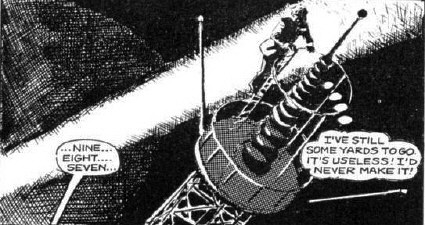 |
 |  | | SCRIPT: Unknown
ART: Gerry Haylock ISSUES: 1160 - 1169
COVER DATES: 9 March 1974 - 11 May 1974
ON TV: Death to the Daleks - Planet of the Spiders (Season 11)
REPRINTS: None The Doctor goes to Australia with radio astronomer Sir Humphrey Picton. At the giant new station, Orion, they are shown the largest, most powerful transmitter man has ever built to probe the skies. When the Doctor sees the size of the wave accelerator, he fears the station may cause damage on other worlds or attract the wrong sort of attention, and he asks the station controller Louis French to cancel its use. French refuses so the Doctor resorts to sabotage, but is thwarted and imprisoned. The test on the accelerator goes ahead as planned, beaming out a message of peace, but the Doctor’s fears are soon proven correct as freak storms threaten the helicopter flying him back to the airport for deportation. The helicopter survives thanks to the Doctor’s quick thinking, but Orion station is devastated and French killed as he deactivates the accelerator. However, the Doctor is more concerned about the effect the accelerator wave will have on the world it is aimed at. |
|  |  | | As freak weather conditions strike the whole world, the Doctor is flown back to England, but the accelerated wave is entering the star system of Epsilon Eradani, about eleven light years from Earth, where it beams to the planet Morrax and lays waste the Morraxan city. Catiba, leader of the Morraxans, swears revenge as the human hand of friendship has almost destroyed their civilisation. For their own safety, they must wipe out the imbeciles. Other Morraxans fear a return to the old ways. The Doctor, meanwhile, finds his cottage flooded and the TARDIS underwater and is forced to call on the Navy to pull it from the flood waters. He travels to Morrax and soon |
|
 | finds the surviving Morraxans. He pleads for the survival of Earth, but Catiba is determined. He loads the Doctor aboard a neutronic missile which is then fired at Earth. The Doctor sabotages the missile and rediorects it back to Morrax. Meanwhile, the Morraxans, aware that it will be many centuries before they can inhabit the surface of their world again, send a plea to the Time Lords. As the missile approaches Morrax, the Doctor ejects the warhead, which explodes in the atmosphere, surrounding the planet in radiation. The Doctor manages to land in one piece and is quickly found by Catiba, who is ready to load him aboard a second rocket. However, the Doctor reveals that he is a Time Lord and can use the radiation in the atmosphere to create a time reverser. This he does, putting Morrax back to how it was before the accelerated wave struck it and giving the Morraxan scientists enough time to think of a way to minimise the damage the wave will cause. |
 |  | | ALTERED VISTAS SAYS:
Reference to the Abbo fence may not be exactly politically correct, but this story is a strong one. Just like The Amateur, it focuses on how destructive science can be if not allied with an equal intelligence, and it is nice to see that not all of the Morraxans believe revenge the best course of action. The ending perhaps strains credibility a little and is a touch too convenient, but that aside this is one of the best Third Doctor strips. |
| |
 | | |  |
 | | |  |
 |  | | DOOMCLOUD |
|  |  | | ALTERED VISTAS SAYS:
Planets going nova and then turning into a galactic cyclone? What scientific gibberish is this?! Actually, the story itself isn’t too bad, and Sarah Jane - in her first ever comic strip adventure - is very nicely characterised. The Zirconians fair less well, being rather generic evil aliens and also rather less well drawn than the human cast, though the Brigadier has reverted slightly to looking like a rather emaciated second hand car salesman. The idea of chosen survivors sitting out a catastrophe foreshadows The Ark in Space by a good seven months. |
|
 |  | | SCRIPT: Unknown
ART: Unknown
COVER DATE: May 1974
ON TV: Planet of the Spiders (Season 11)
REPRINTS: Mighty Midget Doctor Who Comic, 1976, with the Third Doctor’s features replaced with those of the Fourth Doctor (see here). The Zirconian fleet depart from a world that they have exhausted. The world is observed by the Doctor and Sarah Jane Smith aboard the TARDIS, but despite the Doctor’s reassurance that the planet has almost two hundred years of life left in it, it goes nova, catching the TARDIS in the blast. They escape, but just in time to see the nova turn into a galactic cyclone, and the Doctor’s calculations predict that it will pass by Earth as a cloud of deadly gases. He and Sarah Jane go to warn the Prime Minister. The only solution is to select a few survivors and take cover in the nuclear shelters. However, the Doctor is not satisfied that the cyclone was a natural phenomena and he and Sarah soon discover that it is all a plan by the Zirconians to invade Earth. He uses the satellites in orbit around Earth to trigger an explosion that clears the cloud and destroys the Zirconian fleet. |
 |  | | PERILS OF PARIS |
|  |  | | SCRIPT: Unknown
ART: Unknown COVER DATE: May 1974
ON TV: Planet of the Spiders (Season 11)
REPRINTS: None Tired of the motorcar, the Doctor takes Sarah to Paris, 1880, but it’s Paris, New Mexico, not Paris, France, as he’d intended. They are immediately thrust into a conflict between settlers and War Eagle and his Apaches. They soon end up in a wagon train encampment surrounded by Apaches, but the Doctor convinces the settlers to stage a diversion while he and Sarah sneak back to the TARDIS. They are in for a shock, though, as Chief War Eagle is waiting inside. They manage to overpower him and the Doctor pilots the TARDIS to Paris, France, but War Eagle recovers consciousness and escapes into the city. The Doctor corners him, but before he can do anything Buffalo Bill arrives, who is an old friend of War Eagle’s and keen for him to join his travelling Wild West show. The Doctor and Sarah leave, planning a picnic in 1974 beside the M1. |
| |
 |  | | ALTERED VISTAS SAYS:
One strip later, and Sarah now looks nothing like Elizabeth Sladen, even if she is referred to as Liz in one of the captions. Sarah not looking at all like she should will become a regular feature of her tenure on the strip. This strip is just horrible; from its largely poor artwork to its casual racism, there is little to redeem it, and the idea that the Doctor could concuss a man one moment then forget about him the next and dematerialise is improbable to say the least. |
 |  | | WHO’S WHO |
|  |  | | SCRIPT: Unknown
ART: Unknown COVER DATE: May 1974
ON TV: Planet of the Spiders (Season 11)
REPRINTS: None Sarah distracts the Doctor’s attention whilst he is servicing the TARDIS causing a brief surge of power. Suddenly half a million pounds appears in the Doctor’s kitchen cupboard and his car vanishes. Trying to hitch a lift to the local police station, a motorist is alarmed at the sight of the Doctor - and his car is of a make not invented on Earth for another century. The Doctor realises they have been shunted sideways in time, but the biggest shock comes when they find criminal doubles of themselves. The Doctor causes another power surge in the TARDIS console and all four of them are transported - but to a primitive Earth where the Doctor and Sarah leave their doubles. |
| |
 |  | | ALTERED VISTAS SAYS:
Mention of mercury as a component of the TARDIS makes me suspect that the writer of this strip might actually have watched Doctor Who (albeit back in the days of William Hartnell). It’s possible though that he might also have watched Inferno, though the most intriguing thing about this strip are the criminal doubles, who appear to both be human. This strip is lightweight and clearly aimed at a young audience, but not without a certain fun appeal. |
 |  | | SIZE CONTROL |
 | |  |  |  | |  | | 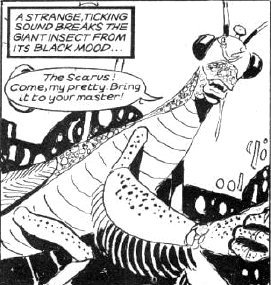 | | | | | | SCRIPT: Unknown
ART: Gerry Haylock ISSUES: 1170 - 1176
COVER DATES: 18 May 1974 - 29 June 1974
ON TV: Planet of the Spiders (Season 11), The Sea Devils (edited repeat)
REPRINTS: Reprinted in TV Comic Issues 1424-1430 with Jon Pertwee’s likeness replaced with Tom Baker’s (see here). Keen to return to Earth, the Doctor detects a ship over fifty kilometres long and is compelled to go and investigate. Following a meteorite storm, the TARDIS is detected by the ship a brought aboard, but the alien Mantis who control the ship are huge and able to hold the TARDIS in their hands, and when they tip the box, the Doctor is knocked unconscious. Eager to learn what they have, the aliens dunk the TARDIS in acid. The acid has no effect, so the Mantis subject the TARDIS to deep x-ray and learn of its occupant. They force him from the craft with intense sound and, eager to learn how the TARDIS is larger on the inside than the outside, increase him in size to their own dimensions. They threaten his life to know the TARDIS’ secret, but further interrogation is disturbed by the arrival of a Tyrraxian/Tyrryxian battle fleet. The Doctor is reduced in size and imprisoned in a jar, but he escapes using sound waves to shatter the glass. The Mantis ship is likewise reduced in size to easily hide from the fleet. Admiral Shotto of the Tyrryxians launches a robot probe to find the Mantis ship and a Mantis underling destroys it, effectively giving away their position. The Mantis leader knows they must return to full size within a few hours or risk damaging their metabolisms, but believes the Doctor may be able to provide a solution to their problem. He despatches a scarab-like creature called a Scarus after the Doctor which captures him, but he is rescued by two Tyrryxians. It seems the Tyrryxians considered the Mantis mindless workers, until one of the Mantis mutated and developed purpose. It then took control of the other Mantis and stole the ship. The Tyrryxians stranded aboard miniaturised themselves to avoid detection. They also tell the Doctor that if the ship doesn’t return to its normal size soon then it will be stuck in those dimensions forever. They hatch a plan, and the Doctor is delivered to the Mantis leader in the jaws of the Scarus. He then tricks the Mantis leader into shrinking down so they can enter the TARDIS. Once inside, the Mantis is overpowered by the Tyrryxians and the TARDIS grows back to its original size, bursting open the Mantis ship. | |
| |
 | | |  |
 | | |  |
 |  | | THE MAGICIAN |
|  |  | |  |  | | 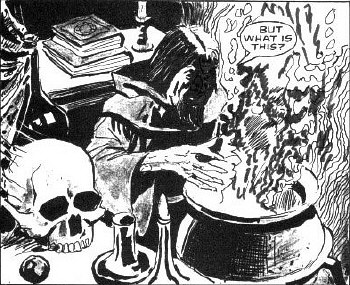 | | | | SCRIPT: Unknown
ART: Gerry Haylock ISSUES: 1177 - 1183
COVER DATES: 6 July 1974 - 17 August 1974
REPRINTS: Reprinted in TV Comic Issues 1397-1403 with Jon Pertwee’s likeness replaced with Tom Baker’s (see here). The Doctor finally makes it back to Earth, but in the Middle Ages, where he is quickly charged with stealing the local Lord’s deer, taken before Sir Geoffrey De Beauvain and soon committed to death, but he is watched by a mysterious hooded stranger. In gaol, he meets Haval, one-time Sergeant at Arms to the Lord of Castle Beauvain, but Beauvain’s returning brother Waldeau brought with him a magaician named Signus. Signus placed the Lord in a deep hypnotic trance. He will die in time and Waldeau will seize power without suspicion being raised. The Doctor and Haval escape their cell, but Signus is watching them with the aid of magic and finally confronts them. He conceals them in his quarters. Waldeau, meanwhile, fears his treachery will soon be discovered as the King is sending someone to investigate the Lord’s dealings. However, Signus hatches a plot to transfer Waldeau’s personality to his brother’s body, and his own personality to the Doctor’s body. The Doctor wakes Sir Geoffrey from his trance then gets Haval away from the castle by means of a primitive hang glider to summon help. However, Signus is aware of their actions and prevents the escape of the Doctor and Sir Geoffrey. As the ceremony to transfer bodies begins, the two men concentrate their wills against Signus and, as Haval and a party of the King’s men come to their rescue, Signus and Waldeau are terrified by an apparition of Signus’ own conjuring and jump into the moat - a moat Signus has previously lined with stakes. | | | | ALTERED VISTAS SAYS:
There is much to commend this strip, including a very nice sense of period conjured with some good art and suitably period-sounding dialogue, and strong characterisation, but - although the Doctor makes it clear that Signus’ magic is nothing but hocus pocus - it is clearly shown to work in the strip, as Signus spies on the Doctor from afar using his cauldron, places Sir Geoffrey in a deep trance and summons apparitions. The Doctor even admits to there being power in the alignment of the planets! So where this strip falls down is in its lack of clarity and consistency, but it’s still a refreshing change from the more usual space adventure and invading monsters. |
| |
 | | |  |
 |  | | THE METAL-EATERS |
 |  | |  | |  | | | | SCRIPT: Unknown
ART: Gerry Haylock ISSUES: 1184 - 1190
COVER DATES: 24 August 1974 - 5 October 1974
REPRINTS: Reprinted in TV Comic Issues 1409-1415 with Jon Pertwee’s likeness replaced with Tom Baker’s (see here). Sigley Dale is the site of a new television relay station, and the site chosen by Professor McTurk and his daughter Catriona to demonstrate their latest engineering feet: a swarm of deadly metal-eating insects. Finding one of the insects in the station ruins, the Doctor runs tests and is able to hatch grubs - grubs that will only eat metal. He also discovers that they can be controlled by radio waves. The McTurks, meanwhile, send their deadly insects to attack a military manoeuvre, but the insect attack is overseen by foreign spies who track the McTurks to their remote Yorkshire farmhouse. The McTurks are busy trying to extort a one million pound ransom from the government, but when the spies attack and steal some of the insects a fatally wounded Professor McTurn orders Catriona to release the insects. Through the police, the Doctor traces the McBrides. He races there with the authorities, but narrowly misses the spies’ car, which crashes into a tree. He is able to save one of them and the box of insects before the car explodes, but the man - Major Pakovsky - attempts to take him hostage. The Doctor outwits him and hurries on to the McTurks’ farmhouse only to discover the insects have been released. Professor McTurk is dead, but the Doctor wins Catriona’s confidence and she agrees to help stop the insects. This they finally do by turning Blackpool Tower into a giant electro-magnet. |
| |
 |  | | ALTERED VISTAS SAYS:
‘It’s... it’s incredible! They’re eatin’ my helmet! Those brutes...’ This is often cited as one of the worst Doctor Who comic strips, but, aside from some nasty padding (the whole spy subplot is almost totally superfluous to the main action), some horrible characterisation for the agents (who are clearly Russian and address everyone as comrade, even when they’re about to shoot them), and ropey dialogue, it’s nowhere near as bad as its reputation suggests. It has some similarities to the identically titled story that can be found here, but is essentially a good fun romp with lots of destruction. |
| |
| |
 |  | | LORDS OF THE ETHER |
 | | |  |
|  |  |  |  | | SCRIPT: Unknown
ART: Gerry Haylock ISSUES: 1191 - 1198
COVER DATES: 12 October 1974 - 30 November 1974
REPRINTS: Reprinted in TV Comic Issues 1416-1423 under the title Moon Exploration with Jon Pertwee’s likeness replaced with Tom Baker’s (see here). An international space rocket to the moon discovers a strange shaft descending many miles beneath the lunar surface. The Doctor urges caution, but a man is sent into the tunnel. In a flash of light, he disappears. The moon’s surface is evacuated immediately, however, as the return capsule is about to make splashdown, something happens and the capsule plunges into the ocean. The Doctor believes its molecular structure has been changed and his suspicions are confirmed when the capsule is hauled to the surface: it has been petrified along with its crew. The Doctor also predicts that they will find some blackish rocks amongst the samples - Crunthel, found in Galaxy 402 - but refuses to divulge any further information which causes major ructions in the international space agency. The suspicious CIA put a man named Harry Godino on the Doctor’s trail, but making it back to England, the Doctor is kidnapped by a taxi. Godino saves him and escorts him back to his cottage. Here, the Doctor hopes to give him the slip, but Godino follows him into the TARDIS as he dematerialises. The arrive on the moon and enter the mysterious tunnel where they discover a strange message on a solid wall: ‘He who enters the holy place of our Lord must be lacking in all evil’. The Doctor discovers a way to open a concealed door in the solid wall and leads Harry into what he realises is a tomb belonging to one of the Lords of the Ether, a race of giants from Galaxy 402 with superior intellect who always bury their dead on passing asteroids. However, Harry is tempted by the vast riches in the tomb and pockets a small jewel. He is immediately rendered unconscious. The Doctor communicates with the Lords of the Ether, telling them of the human interest in the tomb. He is advised to leave. He drops Harry off in America then leaves Earth for a time. When a new rocket lands on the moon all evidence of the tomb has vanished. | | | | ALTERED VISTAS SAYS:
This is a very good strip with a great atmosphere of sinister mystery, the only weakness being that Crunthel is given huge significance in the early part of the story but has really nothing to do with its resolution, other than giving the Doctor - who uses his Smith pseudonym for the first time in the strip - the clue to the involvement of the Lords of the Ether. The early part plays rather like The Ambassadors of Death crossed with a 1970s thriller, the latter part rather more like The Satan Pit - only without an appearance of Satan, obviously. | | | |  |
| |
 | | |  |
 |  | | PETRIFIED |
|  |  | | SCRIPT: Unknown
ART: Gerry Haylock REPRINTS: None Zenos is a peaceful and ancient world, rich in mineral deposits - but it attracts the attention of Parada, ruthless leader of the merciless Groobs who plans to plunder the world. The Doctor is repairing the TARDIS when the Time Lords send him to Zenos. There he finds the inhabitants have been petrified by some kind of ray, and Parada’s Goobs are busy mining. The Doctor is forced to give himself up and is taken into orbit to meet to Parada. There he convinces Parada that Zenos is a rich source of Mennosium, which would allow him to travel in time, but that the way to get the mineral is to reverse the petrification ray. He then hypnotises Parada with his own view screen, recalls the Groobs and triggers an explosion aboard Parada’s ship, ending their plundering ways. |
| |
 |  | | DEAD ON ARRIVAL |
 | | |  | | | ALTERED VISTAS SAYS:
This is one of the first comic strips I remember as a child, and I still think it’s one of the best. The explanation of what’s been going on is satisfying and logical, and the artwork is bold, detailed and beautifully coloured, even if Jo and the Brigadier never actually look like themselves. Best of all, this type of mind-bending story in an annual means you can read it over and over again through the years without ever losing the pleasure of it... and that’s pretty much what I’ve done! |
|  |  | | SCRIPT: Unknown
ART: Edgar Hodges REPRINTS: Doctor Who - Adventures in Time and Space (1981, World Distributors), Doctor Who - Journey Through Time (1985, Cliveden Press) Having visited the planet Mezlob, whose gravity is twenty-seven times as strong as Earth’s, Jo has to enter the TARDIS’ molecular adjuster before returning to Earth. However, the TARDIS is then caught in a cosmic dust cloud... with strange results. Jo finds herself back on Earth, and immediately sees aliens (Breelians) planning to attack Earth once their materialiser arrives. Searching for the Doctor, she finds him in a church placing flowers in an open coffin. Inside the coffin she sees herself. She is unable to communicate and her hand goes straight through the Doctor’s arm. Back at UNIT HQ, the Doctor detects a hole in the space-time continuum and builds a force field to close it, but he receives a mental message to switch the field off. At once he and Jo are reunited back aboard the TARDIS where they hurry through the closing space-time hole. The attacking Breelians in their spaceship are not so lucky and are destroyed, along with their materialiser. The Doctor then explains to Jo what happened: she was projected to an alternate Earth in a molecularly unstable state. However, her presence there robbed the alternate Jo of her life force. The real Doctor was able to communicate telepathically with his counterpart and get the force field switched off long enough to put things to rights. The alternate Jo will now recover from her death-like state. |
| |
 | | |  |
|
 |  | | AFTER THE REVOLUTION |
 | | |  |
|  |  | | SCRIPT: Unknown
ART: Edgar Hodges REPRINTS: None The Doctor and Jo receive a tremendous welcome from Bolgar on the planet Freedonia, a planet the Doctor has visited before when he helped Kamoa and his revolution, but the Doctor immediately detects that something is wrong and builds a circuit jammer. However, he doesn’t get a chance to use it as both he and Jo are imprisoned in a huge cavern with many other poor souls. Here they are attacked by an enormous monster, but the Doctor’s circuit jammer manages to stop it dead. They are summoned by Bolgar and told the truth - the surface-dwellers are all robots, but the more privileged are controlled by Kamoa’s brain cells. The cavern dwellers are indolent and aggressive and must be locked away to preserve the society Kamoe fought for. Bolgar takes them to see the secret at the heart of Freedonia - Kamoa’s living brain. Kamoa tells them that the people soon turned away from his revolutionary ideals so he imprisoned the whole planet. But Jo’s impassioned talk convinces Bolgar that things are wrong, and he unplugs the brain, killing and it and immobilising himself and all the other robots. The slaves are now free to create a new world |
|  |  | | ALTERED VISTAS SAYS:
This is an extremely intelligent comic strip, almost a dialogue about the nature and price of freedom. Kamoa, who the Doctor describes as mad, is never painted in black and white and even offered possible redemption on the final page when the Doctor suggests that Kamoa himself may have ordered Bolgar’s action. |
|
 | | |  |
 | | |  |
 |  | | THE WANDERERS |
 |  | |  |  |  |  |  |  |  |  |  | | SCRIPT: Unknown
ART: Gerry Haylock ISSUES: 1199 - 1203
COVER DATES: 7 December 1974 - 4 January 1975
ON TV: Planet of the Spiders (edited repeat), Robot (Season 12)
REPRINTS: Reprinted in TV Comic Issues 1404 - 1408 with Jon Pertwee’s likeness replaced with Tom Baker’s (see here). The Doctor is held in space and begins to believe that he is being punished by the Time Lords for his involvement in the lunar affair, then, after a nightmare journey through time and space, he arrives in an unknown galaxy alongside a gigantic spacecraft. For all its massive size, the ship is crewed by one ancient astronaut named Alto. But the last act of Alto’s commander was to release a cryogenically preserved sleeper, and the computer tells Alto that the man means trouble and should be terminated. The Doctor lands aboard the ship and meets Alto who explains that Thusion scientists predicted the death of their world with accuracy and so they built the largest spaceship they could and selected those who would travel on it to a new world. These survivors were placed in suspended animation whilst a crew of twenty piloted the ship in search of a new home. But they made a solemn vow not to land on any planet already supporting intelligent life, and so their quest continues seemingly endlessly. The recovered sleeper - Zeros - discovers the number of worlds rejected because of the vow and also discovers that the ship is running low on fuel. When the Doctor and Alto find him, he is armed and determined to wake the other sleepers and take over the nearest habitable world regardless of what life lives there. The Doctor and Alto take shelter in the TARDIS until Zeros gives up his attempt to kill them and goes instead to rouse the other sleepers. The Doctor then connects the TARDIS to the ship’s controls and moves the ship to another galaxy where a suitable world awaits them. The sleepers claim their new home and Zentos is deposed. | | 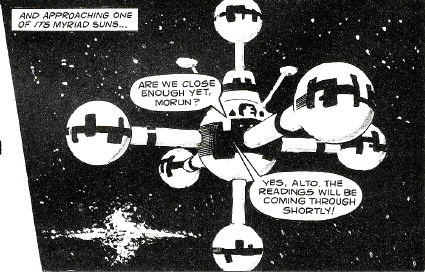 | | | | | 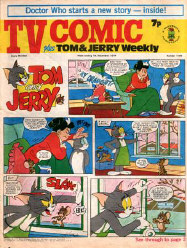 | | 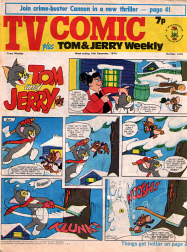 | | | | | 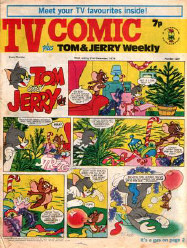 | | 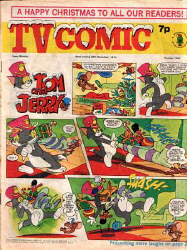 | | | | ALTERED VISTAS SAYS:
This is a pretty good story to see out the Third Doctor’s regular run on the strip, though it takes an age for the Doctor to actually arrive at the ship and get involved in its predicament and it does feel rather padded as a result. It is hard not to feel a certain amount of sympathy for poor Zeros, even if the Doctor does describe him as a fool, and his action of staging a revolt (especially when Alto planned to terminate him) doesn’t seem without justification, particularly if the alternative is the complete extinction of his race. | | | | | | 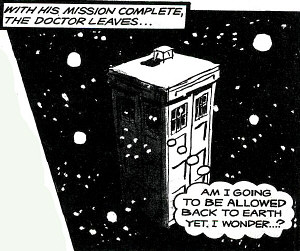 | | | | | | |  | | | |
 | | |  |
 |  | | TERROR OF THE AUTONS |
|  |  | | SCRIPT: Robert Holmes
ART: Colin Howard
LETTERS: Glib ISSUE: 164
COVER DATES: 8 September 1990
REPRINTS: None In a similar vein to the 1972 Radio Times Colony in Space adaptation, this Terror of the Autons one page strip turns the opening moments of the story into a comic strip. | | | ALTERED VISTAS SAYS:
This adaptation is a very nice idea, and it’s a shame Doctor Who Magazine only did one other strip in this fashion (The Masque of Mandragora). The artwork is pretty good and the colour is lovely, though it must have been a very expensive way to introduce a synopsis and fact file. |
| |
 |  | | THE MAN IN THE ION MASK |
|  |  | | SCRIPT: Dan Abnett
ART: Brian Williamson
LETTERS: Helen Stone
EDITOR: John Freeman REPRINTS: None Following the incident at Devil’s End (The Daemons), the Doctor is summoned to Aylsebury Grange where the Master is being held. The Master initially tries to convince the Doctor that he is a reformed character, but soon reveals his true self by attempting escape with the aid of a holographic duplicate of himself. However, the Doctor also has a holographic duplicate, and the Master is caught before he can leave the building. |
|
 |  | | ALTERED VISTAS SAYS:
The story is lightweight but aims for something deeper in its closing panels. It characterises the Doctor and the Master well, but generally feels a little too studied and self-conscious - much like the artwork, which manages some fairly good likenesses of the regulars but never really springs to dynamic life. This strip marks Benton’s comic strip debut. |
| |
 |  | | CHANGE OF MIND |
|  |  |  |  | |  | | | | SCRIPT: Kate Orman
ART: Barrie Mitchell
LETTERS: Warwick Gray
EDITOR: Gary Russell ISSUES: 221 - 223
COVER DATES: 18 January 1995 - 15 March 1995
REPRINTS: None Liz and the Doctor are travelling to Prague to attend a conference on telekinesis organised by Professor Hardin, Liz having been a last minute replacement for two of her colleagues, when the plane is attacked by a telekinetic force. A woman aboard is also telekinetic and stops it crashing, but at the cost of her own life. Liz recognises her as one of Professor Hardin’s students and the Doctor realises they will find answers back in Cambridge. Professor Hardin, meanwhile, is approached by an ex-UNIT man named Hank MacBeth, and Hardin reveals that he has operated on a human being to enhance their telekinetic powers. However, their meeting ends when the Doctor bursts in, but the confrontation does not go well. MacBeth, who also has latent powers, then runs into the man who crashed the plane. The man - Nathan - knocks him unconscious with the power of his mind. ‘Three down, two to go,’ he says. The Doctor calls in the Brigadier. He suspects that the student on the plane was killed by Hardin to stop her revealing his research at the conference. He also suspects that Hardin is trying to create an army of psychic killers. However, further discussion is prevented when Hardin uses Nathan to stage a psychic attack. The Doctor confronts Hardin - who has killed Nathan - while Liz and the Brigadier discover MacBeth who confirms the Doctor’s suspicions. Hardin attacks the Doctor with his telekinetic powers but is saved by the Brigadier who fires at Hardin. Hardin holds the bullet back with his mind for so long, but eventually allows it to kill him. |
| |
 |  | | TARGET PRACTICE |
|  |  | | SCRIPT: Gareth Roberts
ART: Adrian Salmon
LETTERS: Elitta Fell
EDITOR: Gary Gillatt ISSUE: 234
COVER DATE: 17 January 1996
REPRINTS: None The Brigadier drags the Doctor and Jo away from a science conference to Base 43, UNIT’s new training centre populated with dummies of his old adversaries, where they meet Colonel Ashe. However, the Brigadier did not send for them as he has just returned from Geneva and is back at UNIT HQ. The Doctor, though, is already suspicious and his suspicions are confirmed when Colonel Ashe fails to recognise an Ogron from an Auton. However, after escaping the Colonel he learns that the man has been sent from Russia to recruit him and he accepts the Colonel’s offer, only to knock him unconscious just as the Brigadier arrives. |
| |
 | | |  |
|